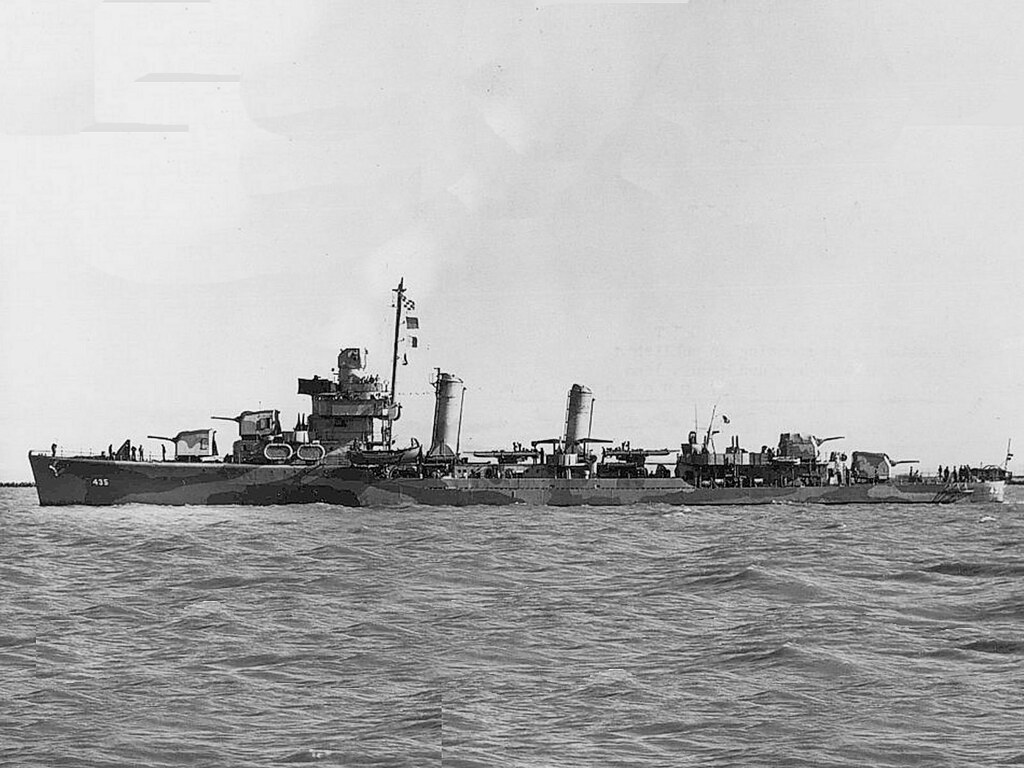


Posted on 03/04/2017 9:23:23 PM PST by Jeff Head



Gleaves Class Destroyers
The Gleaves-class destroyers were a class of 66 destroyers of the United States Navy built from 1938–42. They were designed by Gibbs & Cox. and these were the main production destroyers of the US Navy when it entered World War II. The succeeded the Benson class of which 30 were built before and into World War II.
They were initially meant to be a part of a 24-ship class authorized for 1938–40. Bethlehem Shipbuilding, whichhad been given a contract to build six of these destoyers requested that the six ships designed by them use less complex machinery. Initially, Gleaves and Niblack, although designed by Gibbs & Cox and built by Bath Iron Works, were to follow the earlier Benson design. S,. when BVethlehem started building it temporarily made the USS Livermore the lead ship with more complex machinery and the class was initially called the Livermore class. However, it soon proved possible for Gleaves and Niblack to be built to the Livermore design that Bethlehem was using, and so this allowed Gleaves to be the first in class since it was completed before Livermore and had a lower hull number.
Eighteen of these were commissioned in 1940–41. The remaining 48 were authorized in 1940–42 when it became more and more clear that the US was going to be pulled into the war and as the demand to help England with tranpsort duties across the Atlantic continued to rise.
During World War II the Benson and Gleaves class destroyers were the backbone of the pre-war Neutrality Patrols and brought the action to the enemy by participating in every major naval campaign of the war around the world.
It was not until the Fletcher class was built that a design had more vessels built. In fact, the larger Fletcher class was authorized in 1941 as the US entered the war and 175 of those destroyers wee built over a three year period at several yards around the country. So, with the Benosn, the Gleaves, and then the Fletcher class, by 19440, the United States had built 272 destroyers and commissioned them and brought them into the War effort. The charateristics of these frigates are as follows:
Displacement: 1,630 tons
Length: 348 ft 3 in (106.15 m)
Beam: 36 ft 1 in (11.00 m)
Draft: 11 ft 10 in (3.61 m)
Propulsion:
- 50,000 shp (37,000 kW);
- 4 boilers;
- 2 propellers
Speed: 37.4 knots (69 km/h)
Range: 6,500 nmi (12,000 km; 7,500 mi) at 12 kn (22 km/h; 14 mph)
Complement: 16 officers, 260 enlisted
Armament:
5 × 5 in (127 mm) DP guns,
6 × 0.5 in (12.7 mm) guns,
6 × 20 mm AA guns,
10 × 21 in (533 mm) torpedo tubes,
2 × depth charge tracks
USS Grayson, DD-435
I am building this vessel as the USS Grayson, DD-435, even though it was sold as the USS Livermore, DD-429.
Grayson was launched in August 1940 and commissioned in February 1941. Before the US officaillt entered the war, and immediately thereafter, Grayson was involved with escorting convoys across the Atlantic to England.
I chose to build this model as the USS Grayson because it was one of four Gleaves class destroyers that served with the USS Hornet, CV-8 (TF-18), and USS Enterprise, CV-6 (TF-16), during the early days of the war and in the first major offensive strike at Japan, during the Doolittle Raid on Japan in April 1942. These are the four Gleaves class that accompanied the raid:
USS Gwin, DD-433
USS Mredith, DD-434
USS Grayson, DD-435
USS Monssen, DD-436
...all but Grayson were sunk before the war ended and only Grayson survived the war.
After ten months patrolling and protecting convoys in the icy North Atlantic, Grayson was ordered to the Pacific to join an American fleet battered after Pearl Harbor and around the Philippines, but resolutely carrying the war to the enemy. As stated, ssailed from San Diego on 2 April 1942 as part of aircraft carrier Hornet's escort and rendezvoused at sea 13 April with Enterprise under Admiral William F. Halsey, Jr. From this fast carrier force, steaming less than 800 miles from the Japanese home islands, General Jimmy Doolittle launched his B-25 raid.
The task group sailed into Pearl Harbor on 25 April. Grayson departed almost immediately for repairs in California, but soon returned to the Pacific war.
Guadalcanal
Grayson found herself with a fast carrier force as she sailed from Pearl Harbor July 15, 1942, to escort Enterprise and Hornet. Reaching Guadalcanal via Tongatapu on August 7, 1942, the carriers launched their planes to cover Marine landings there, and then operated in the area to block Japanese reinforcements. As they maneuvered off Guadalcanal, Enterprise was hit by Japanese bombs on 24 August in an action filled half-hour which saw Grayson down two planes and damage a third.
with the Enterprise damaged, the task group dispersed, Enterprise returning to Pearl Harbor for repairs, and Grayson joined Task Force 11, built around Saratoga under Admiral Frank Jack Fletcher. Action soon followed. Sighting a Japanese submarine on the surface on August 25th, Grayson closed for the kill. After expending 46 depth charges in a series of five attacks, the destroyer saw a huge air bubble and oil slick rise to the surface indicating that they had sunk an Imperial submarine.
The battle-proven destroyer and crew remained in the bitterly contested waters around Guadalcanal for nearly eight months in a variety of duties. During that time, many of her sisters were sunk. Grayson convoyed troop transports loaded with reinforcements from Nouméa and other staging areas to Guadalcanal, patrolled in "The Slot", served as a radar picket ship, and performed valuable rescue work. On 18 October she picked up 75 survivors from her sister Gleaves destroyer, USS Meredith, which had been sunk by aerial torpedo on 16 October, and helped escort the barge Vireo, loaded with needed fuel and ammunition, to Guadalcanal.
Kolombangara
Returning to Pearl Harbor April 15, 1943 for overhaul, Grayson continued on to the States for further repairs and finally sailed to New Caledonia, and arrived there on Sptember 24th.. She accounted for at least four and possible two more Japanese barges loaded with evacuees from Kolombangara during three nights of action, 30 September – 3 October, with DesRon 21 under Commander A. D. Chandler. After three months of patrol duty, Grayson sailed for Puget Sound Navy Yard December 16, 1943 for another overhaul.
1944
Grayson soon returned to the Pacific, putting in at Majuro Atoll, Marshall Islands, February 10, 1944. Patrol duty in the Solomons, Carolines, and Marshalls occupied her the following six months. On March 30, 1944, Grayson supported initial assault landings on Pityilu Island, Admiralties, from April 22-24 she was fighter-director ship for the landings at Tanahmerah Bay, Dutch New Guinea. She then bombarded Biak Island on May 27 and Noemfoor Island on July 2 prior to invasion landings.
On September 1, 1944 Grayson joined TG 38, for carrier strikes against the enemy in the Palau Islands, scene of the next major invasion. She returned to Seeadler Harbor on September 30th an then sailed on October 2nd for a major strike against Okinawa and the Philippines. Japanese planes harassed the withdrawal, and o October 15th Grayson rescued 194 men from the torpedoed light cruiser Houston, who was towed safely to Ulithi.
Prom Ulithi, Grayson sailed straight to Saipan, where on November 3rd she took up radar picket and lifeguard duty. Finally Grayson was ordered home, reaching Seattle June 9, 1945 for her first real rest since the war began.
End of World War II and fate
Grayson returned to Pearl Harbor September 1, 1945, the day of the signing of the Articles of Surrender in Tokyo Bay. After brief training she sailed for the United States. transiting the Panama Canal on October 8th, 1945, she put in at Charleston, South Carolina, October 16th. Eleven days later the battle-scarred "tin can" hosted over 5,000 visitors as a grateful and jubilant public paid tribute on Navy Day.
Thereafter, Grayson remained at Charleston until decommissioned, February 4, 1947, and was placed in reserve.
She remained in reserve for many years and was finally struck from the Naval Vessel Register on 1972 and sold in June 1974 for scrap.
For her services in world Wr II, Grayson received 13 battle stars.
Introduction and What's in the Box - February 27, 2016
This Dragon kit is one of their Modern Sea Power Smart Kits. Tt comes with many detailed and small plastic parts which have been very finely molded.
The kit has 13 plastic sprues and 2 Phot etch Sprues. The photo etch contains many detail parts for sensors, ladders, equipment, ladders...but no railing. I used a set of Tom's MOdels 1/350 scale railing to put railing on the ship.
The ship also comes with six crew members...but I did not paint or use them, thugh tey are very decent 3D pieces.
There are almost 300 parts altogether, and they go together nicely for such a small vessel.
Many, many fine details. One will have to be patient with these parts in orde to put the vessel together properly, but it looks like it will make a very nice kit.
The instructions are very well done on eight pages, two of which make for a good, color layout of the paint scheme.
The decals are well done too, though I did not use the pathway markings. For one, they are relatively dark gray and were hard to see with the deck coloring.
The hull can be built as a waterline model of you wish, though I chose to build the kit with the full hull.
All in all, this is a very good Dragon model and it really compares well to similar Trumpeter models for the amount of detail.
I would recommend these "Smart MOdels" to anyone wanting a very decent build.
Here's how the kit looked out of the box:
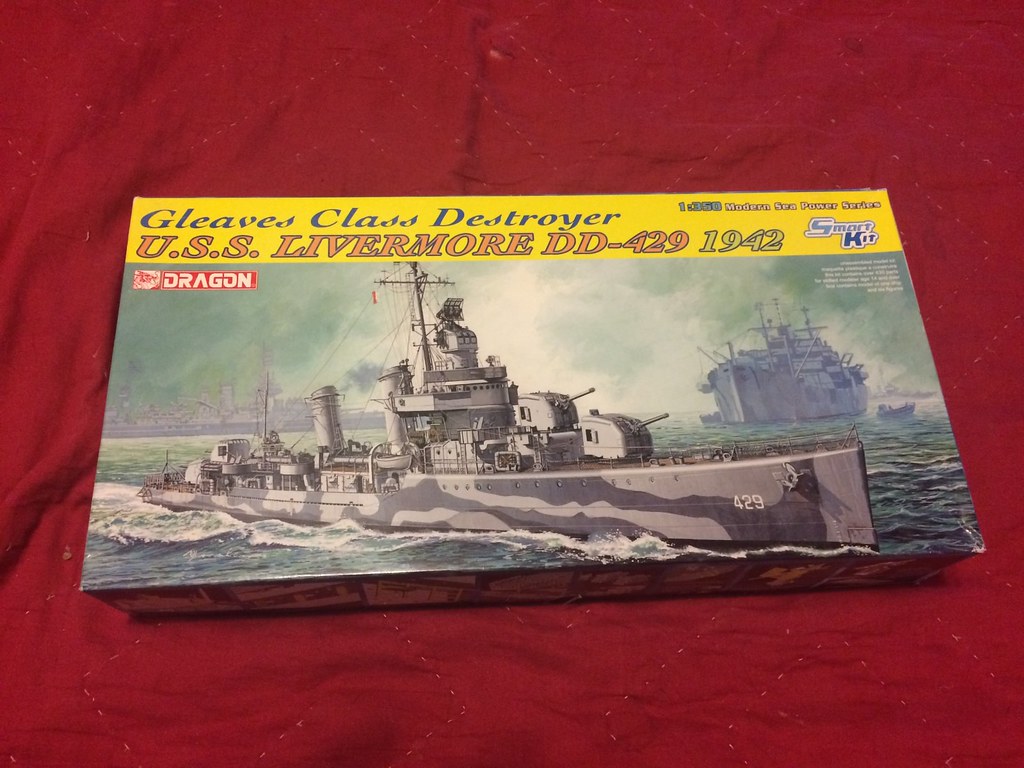

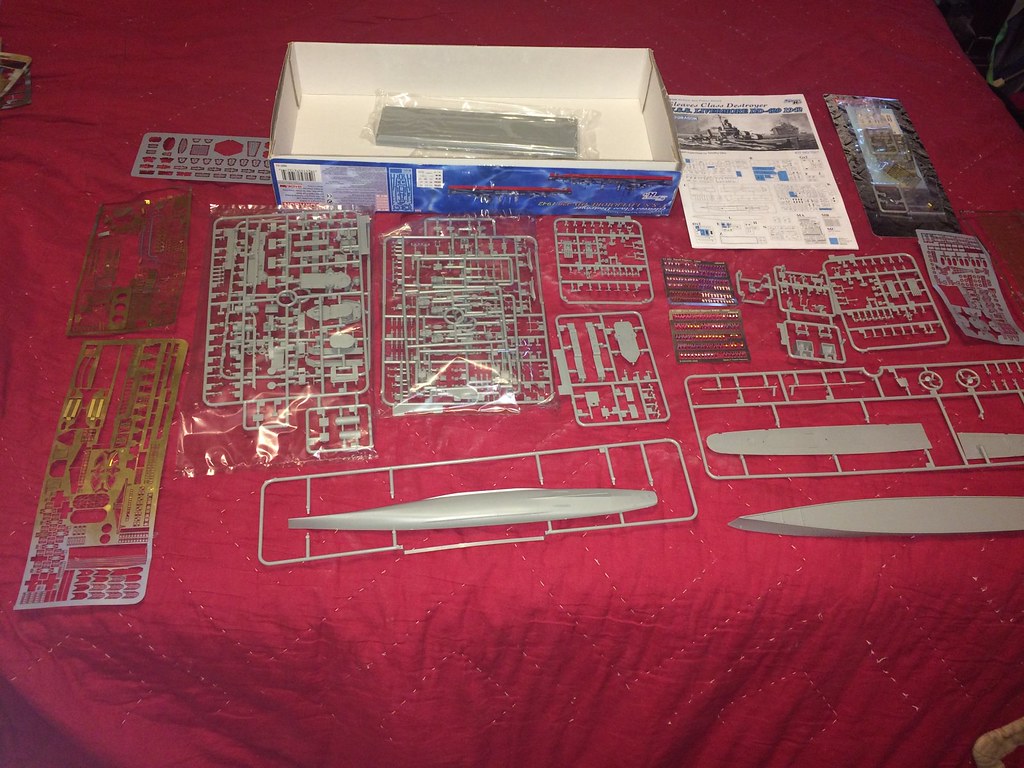
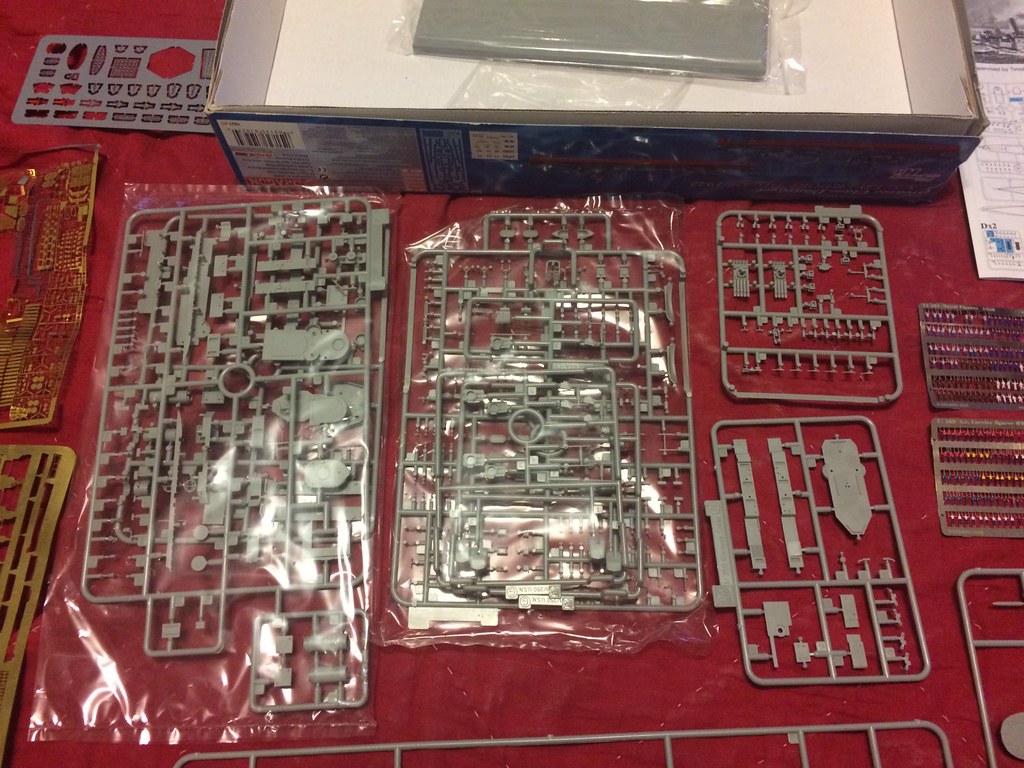
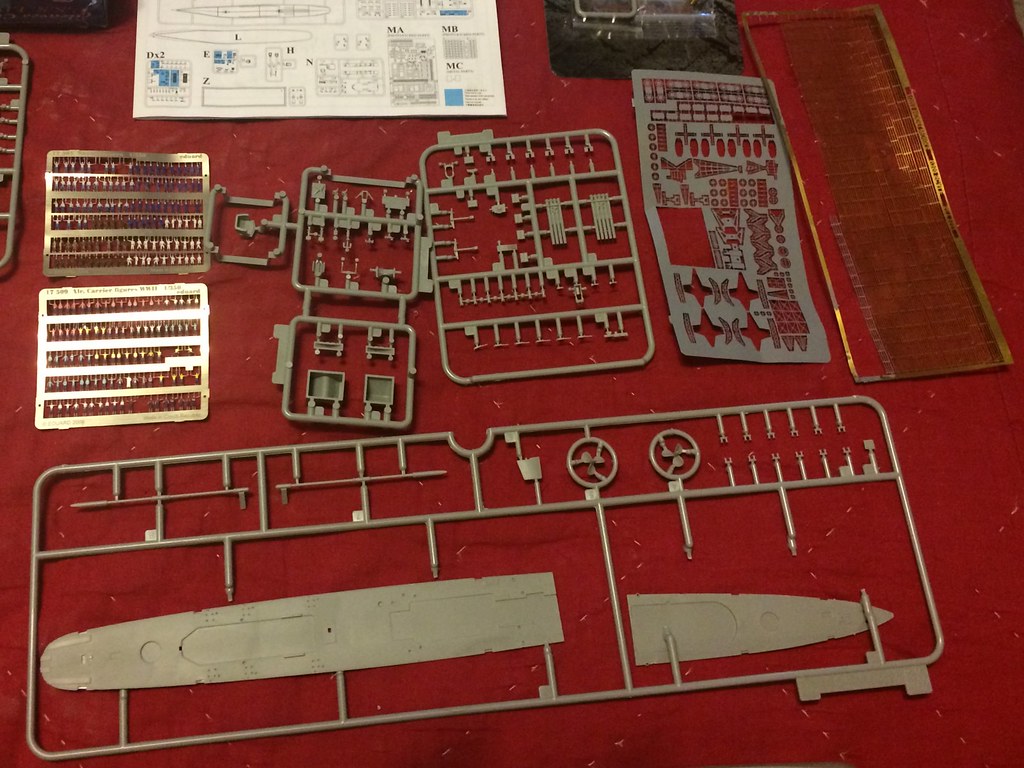
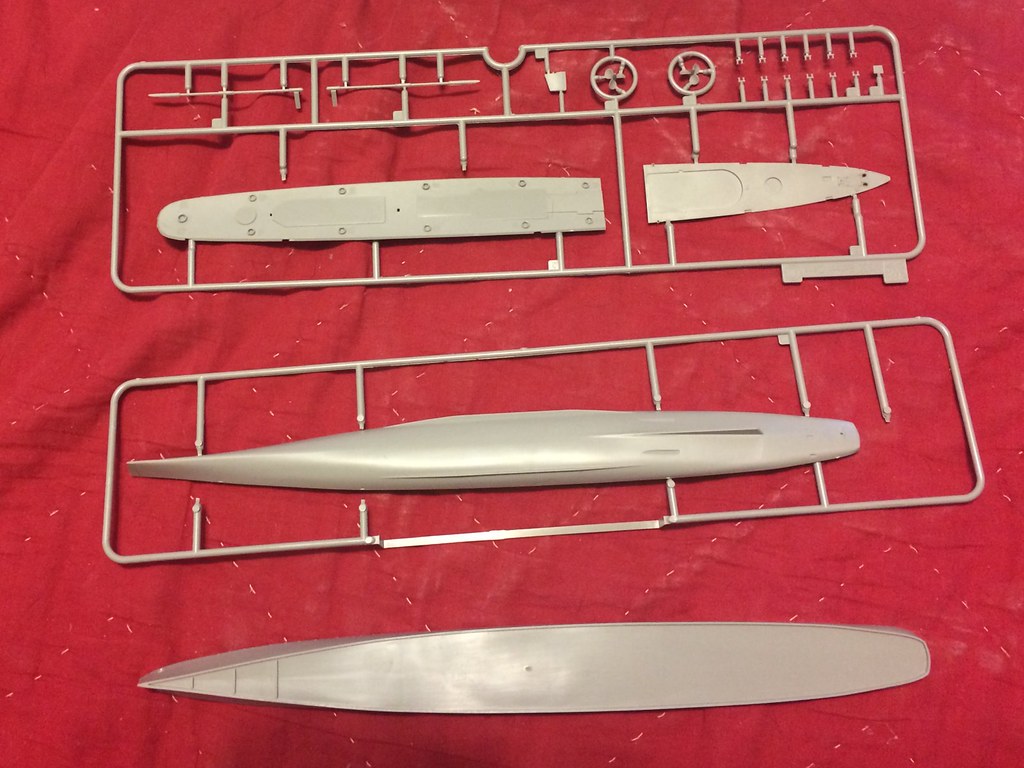
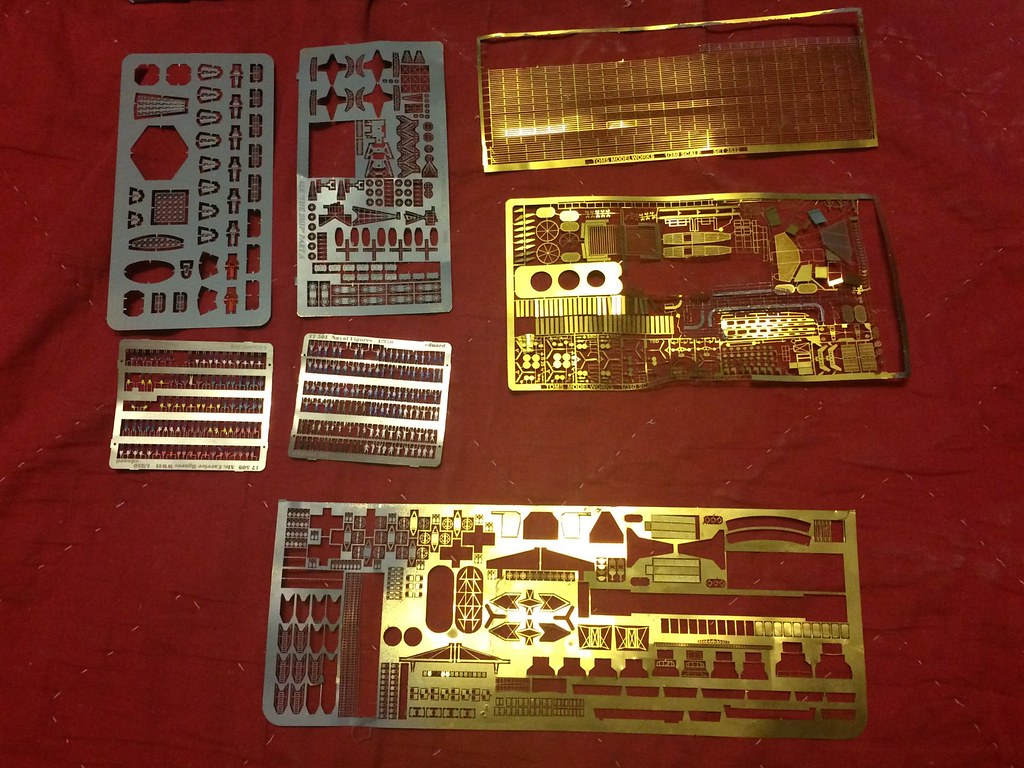
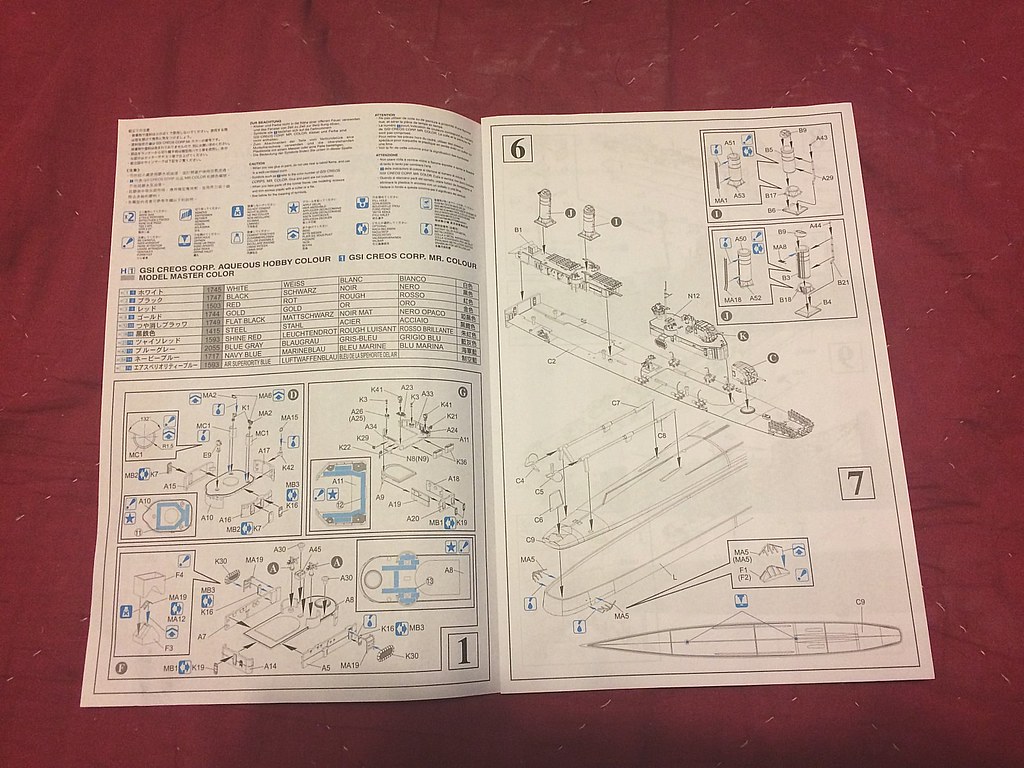
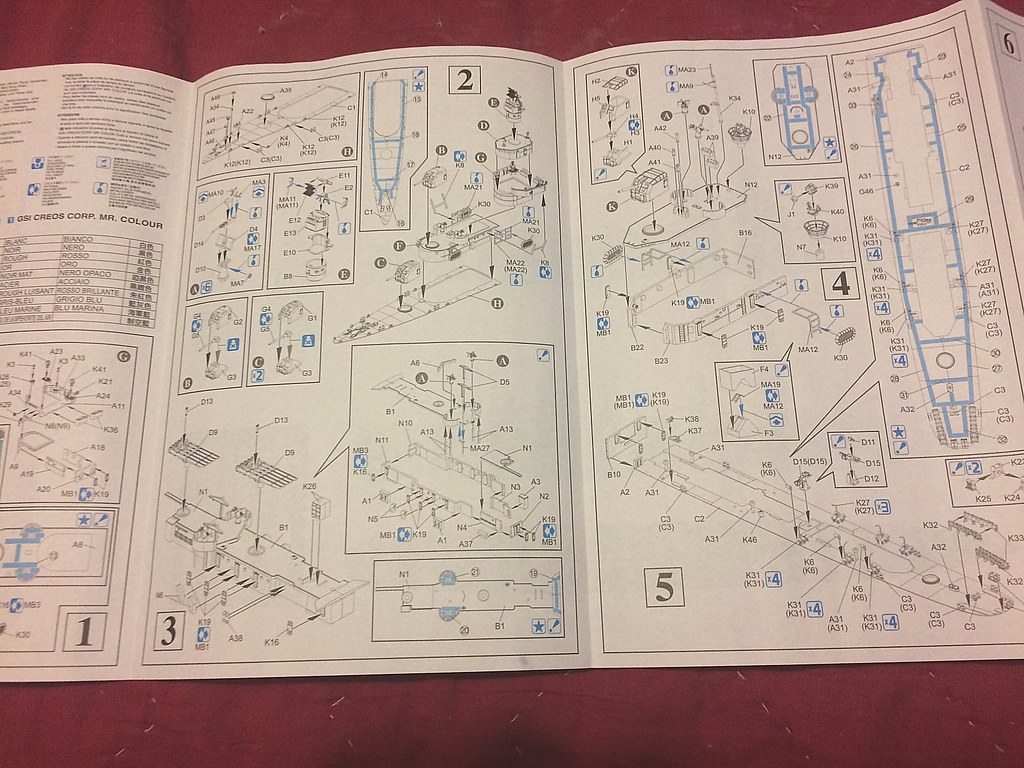
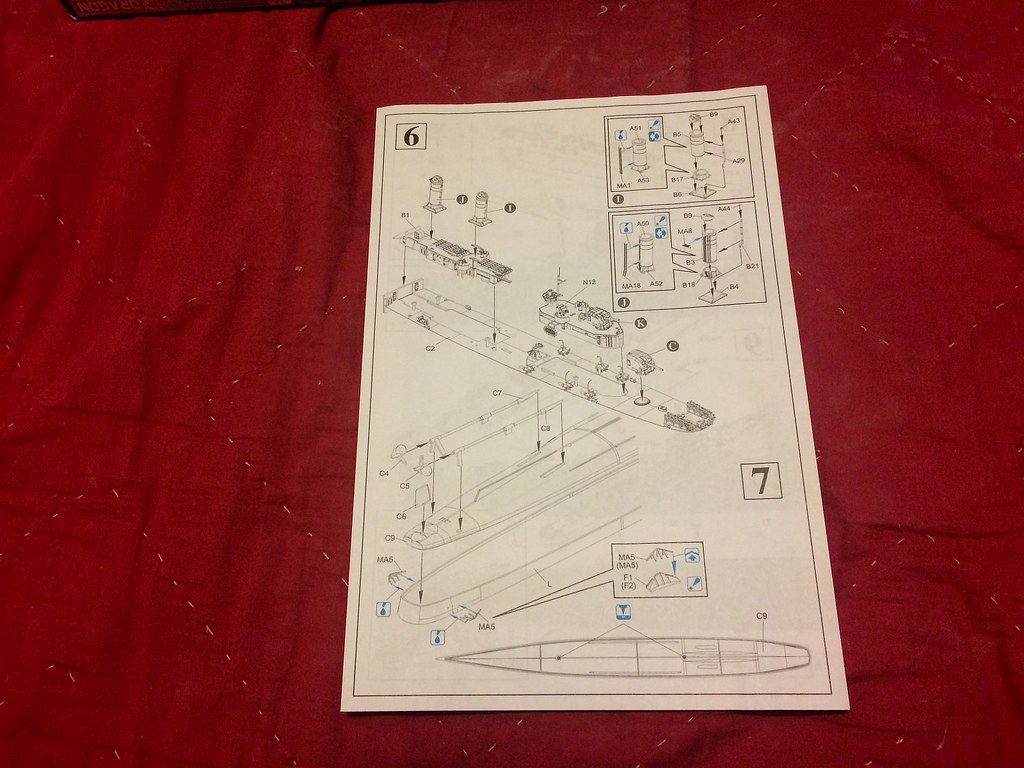


The Build - Hull, props, and main decks - March 1, 2017
I started off by painting the hull, tand the vertical surfaces in neutral gray before adding the came, and the decks in a flat dark gray.
I then built the hull, added the props, and then added the main forward and at decks.
Here's how that all went:

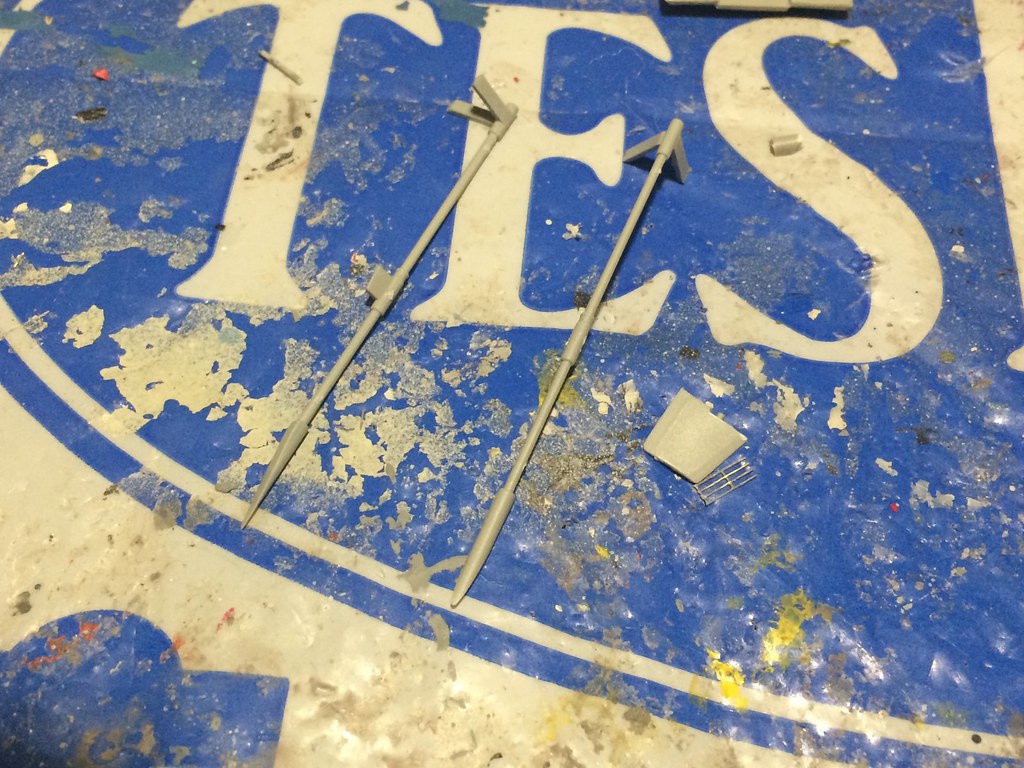


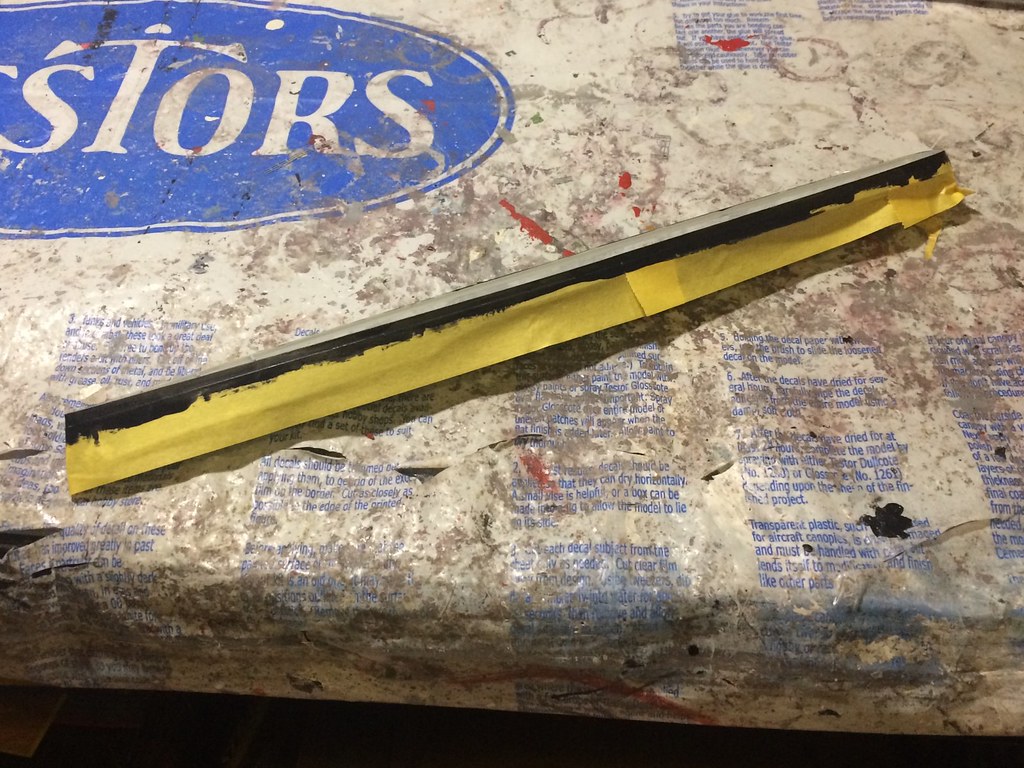
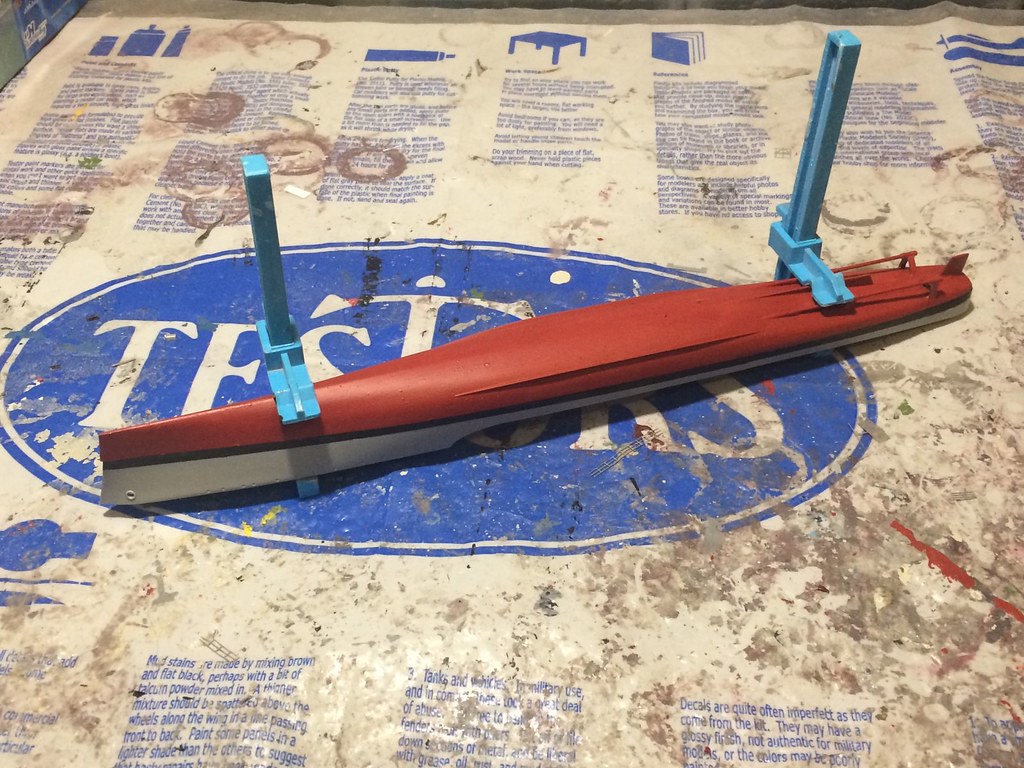

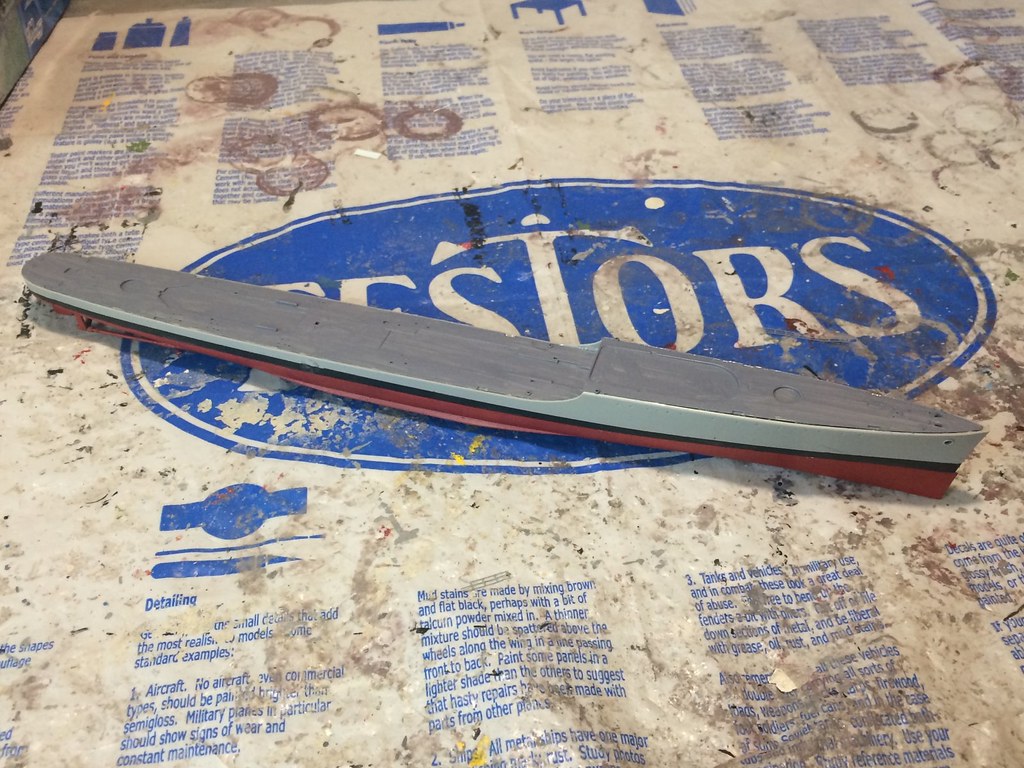
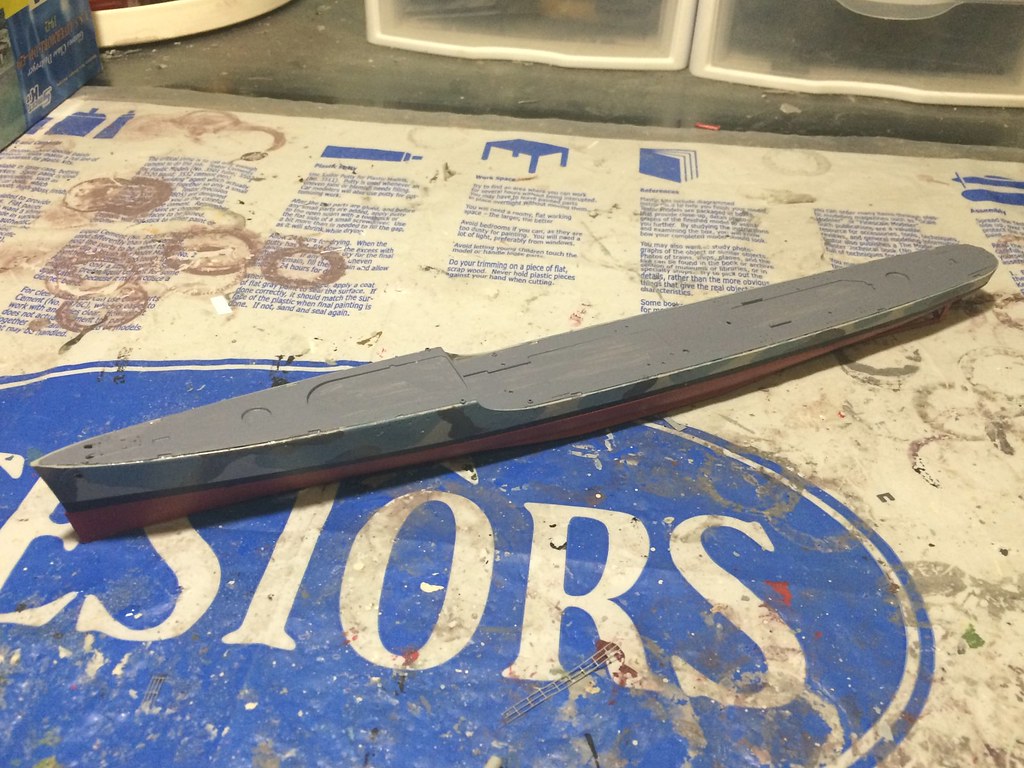
The Build - Main Deck houses, funnels, and main armament - March 2, 2017
Next I built the main deck houses. There are thee of these. The forward gun mount and bridge, a central deck house where the funnels and the torpedo luanchers along with one of the .50 caliber sections, and then an aft deck house for the another .50 caliber section and the after gun mounts.
I also then painted the cam scheme, using a Ocen Blue Gray that I mixed, a Ryal Naval Gray, which is dark for the upper surfaces, and a darker gray for the darker color on the hull. I then built the funnels and attached them, and then built the four 5" guns and tow torpedoe launchers, each mounting five torpedoes.
Here's how all of that went:
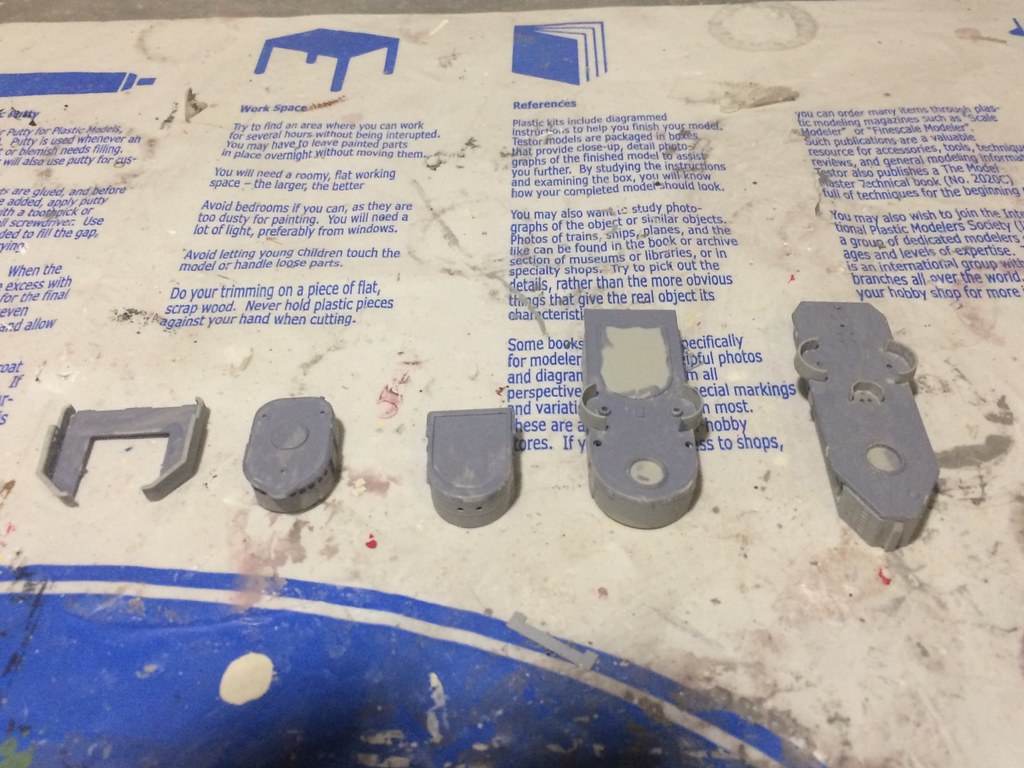

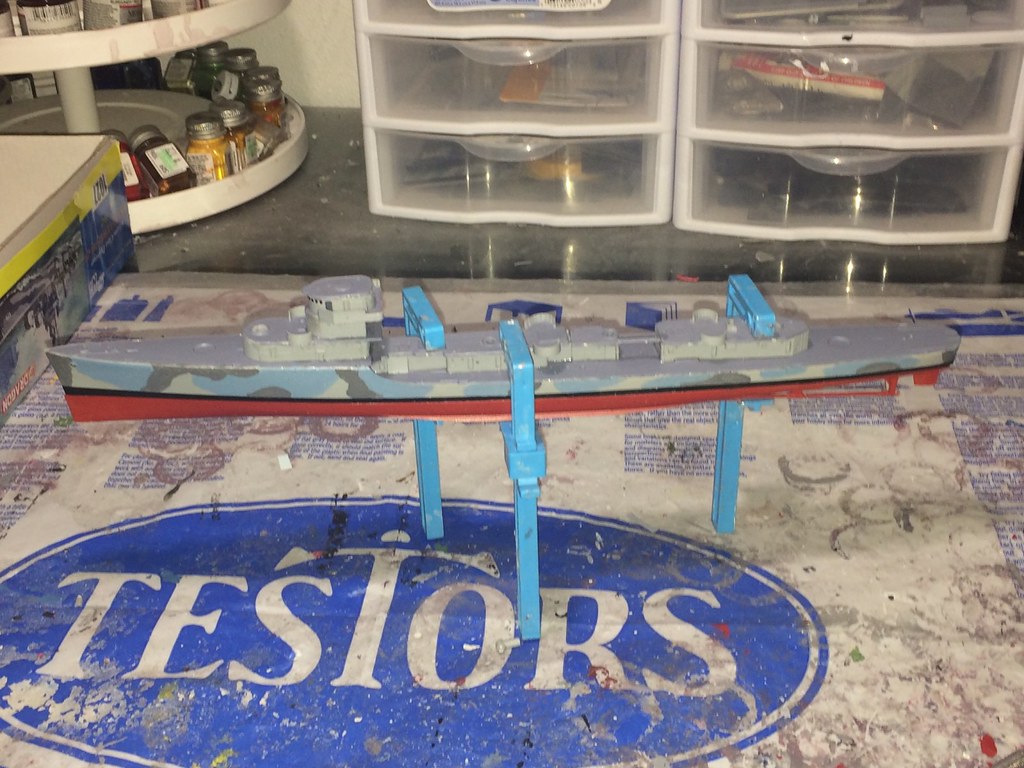


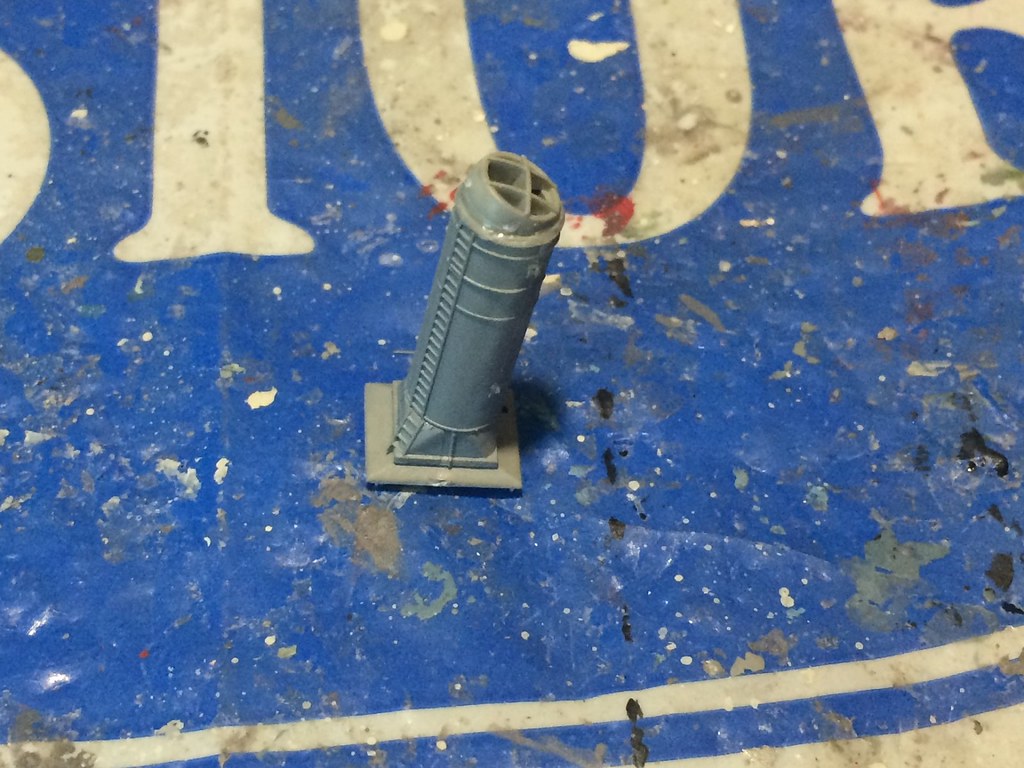

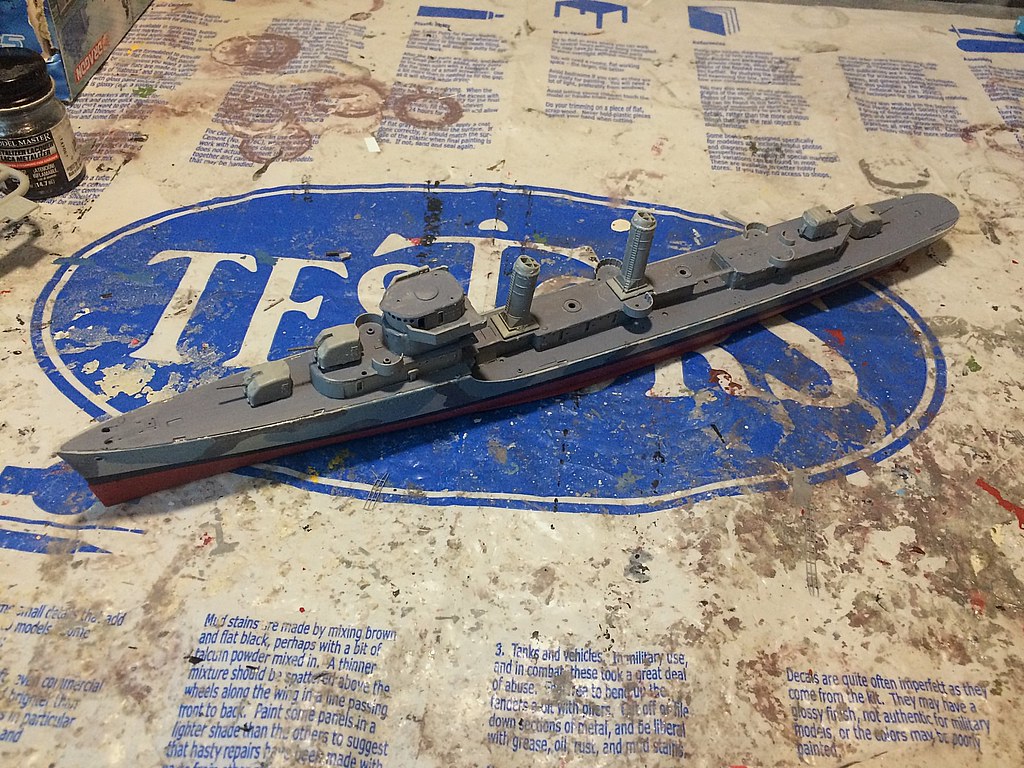
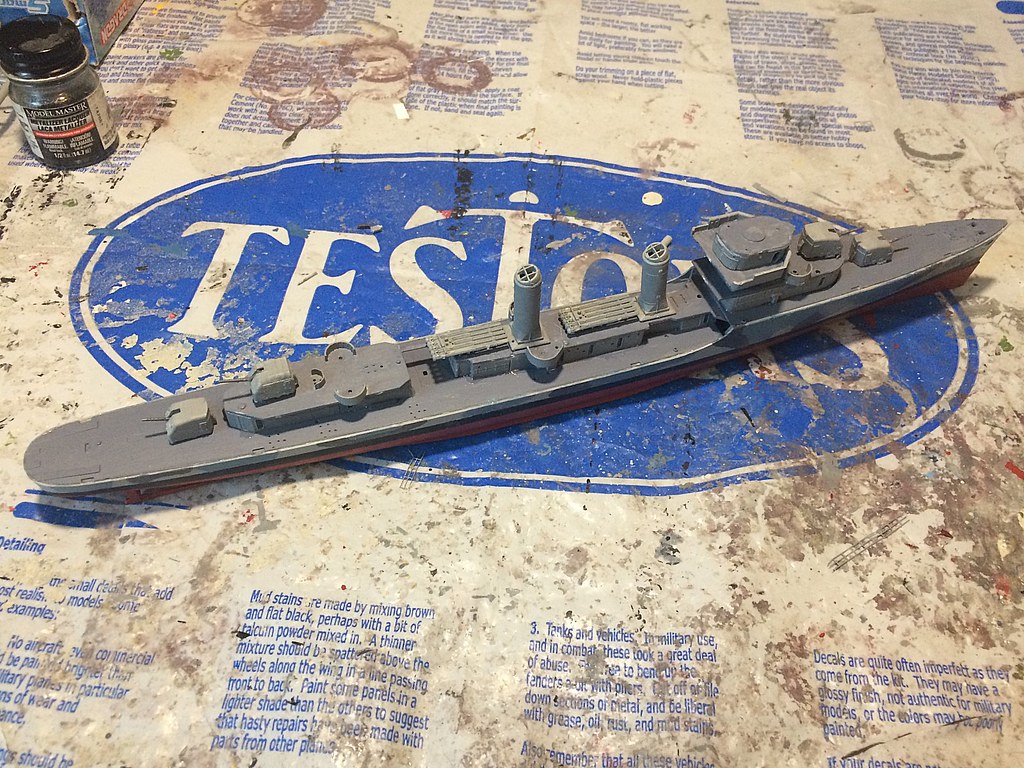
The Build - Main Mast, .50 cal MGs, LIfe Boats, Life Rafts - March 4, 2017
At this point I was ready to build the main mast. I used some of the Pht Etch here and the prts here are very fine and much care has to be taken not to bend or break them, including the mast and cross arms.
I then similarly had to exhibit care with the very small .50 cal machine gun assembles. There are six of them and they are tiny...but very well modled.
Finally I bilt the Life boat and life raft assemblies and placed them, having to place the photo etch addes to the mid ships area because they are underneat the life boats and davits.


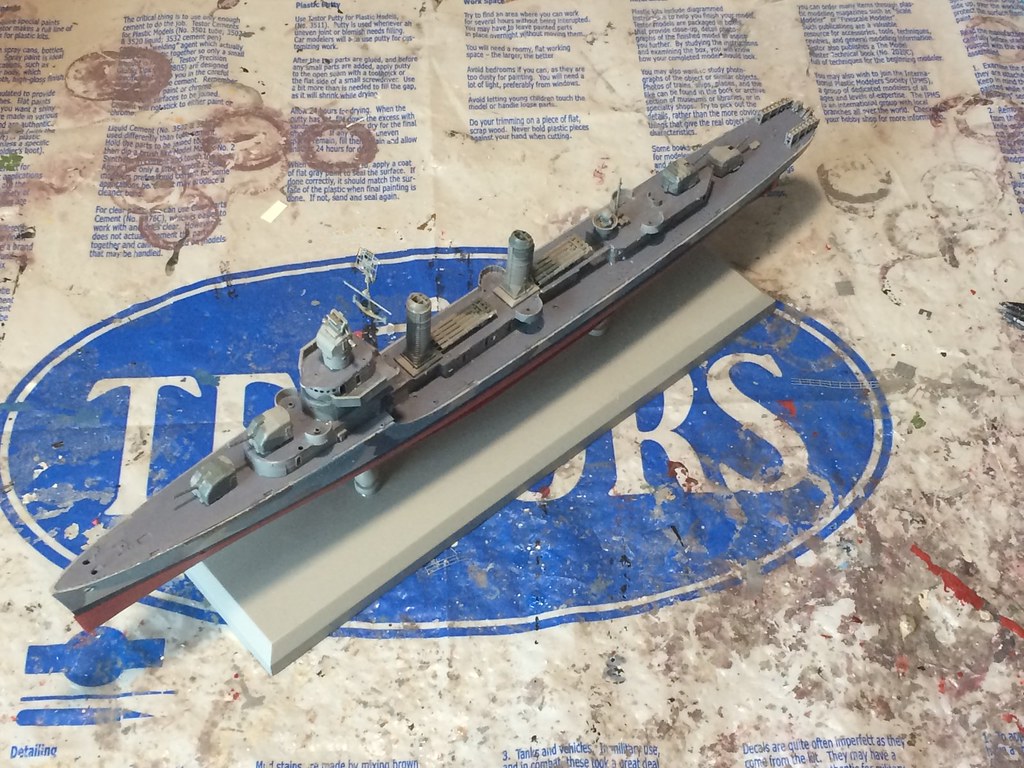


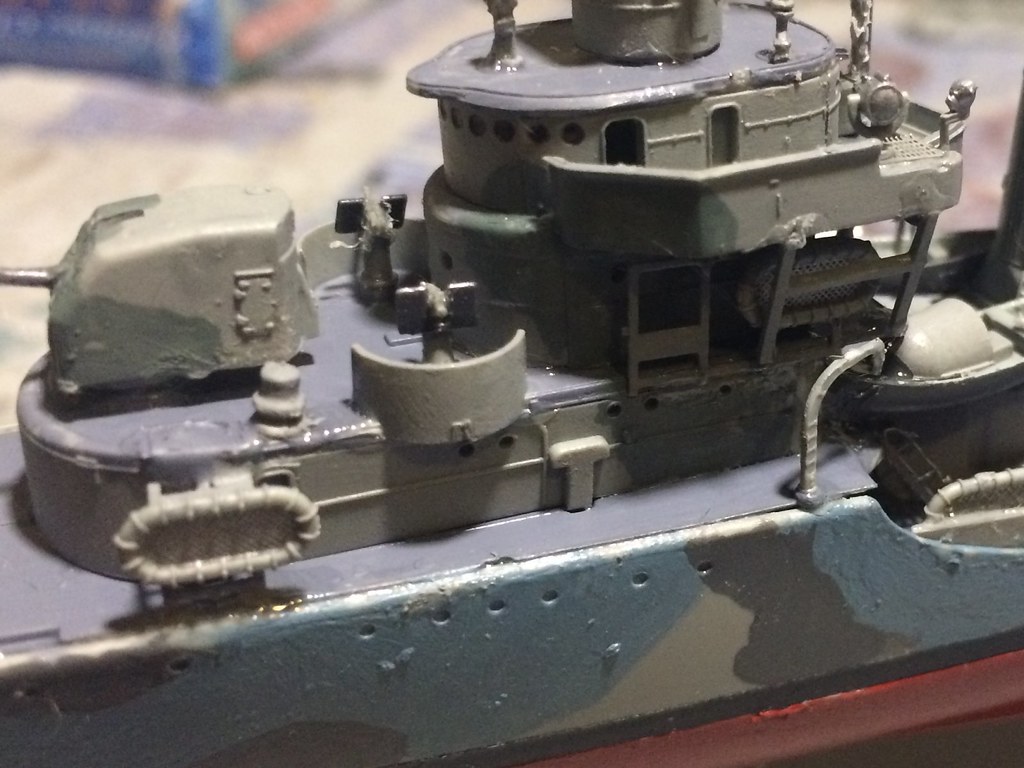
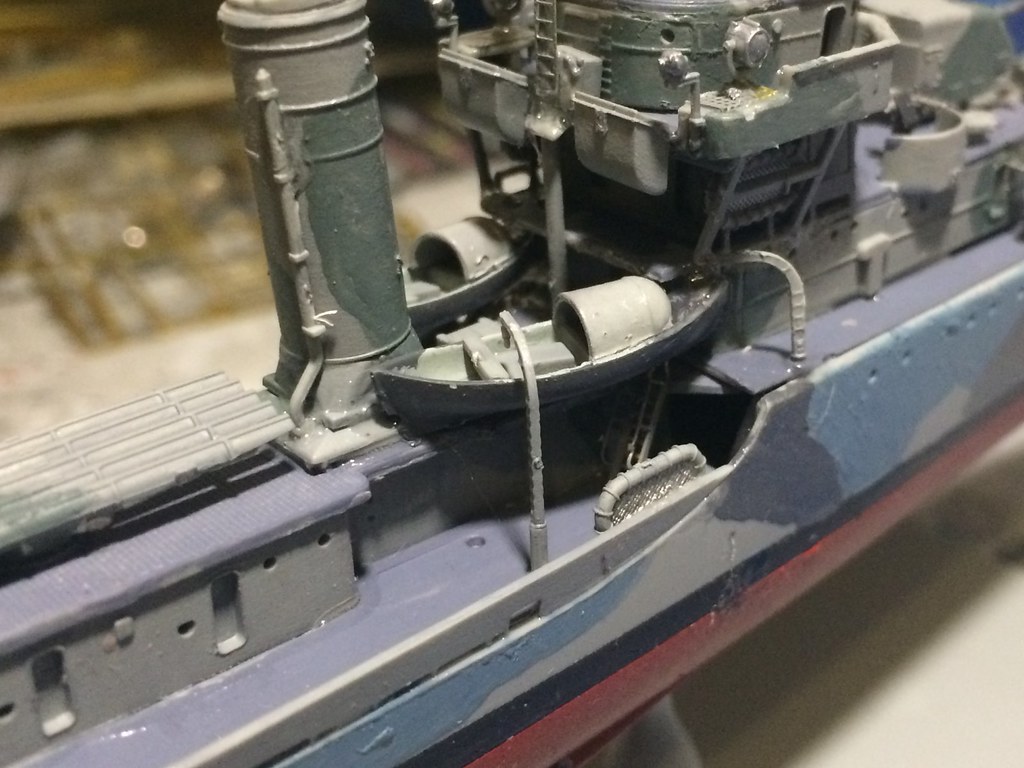
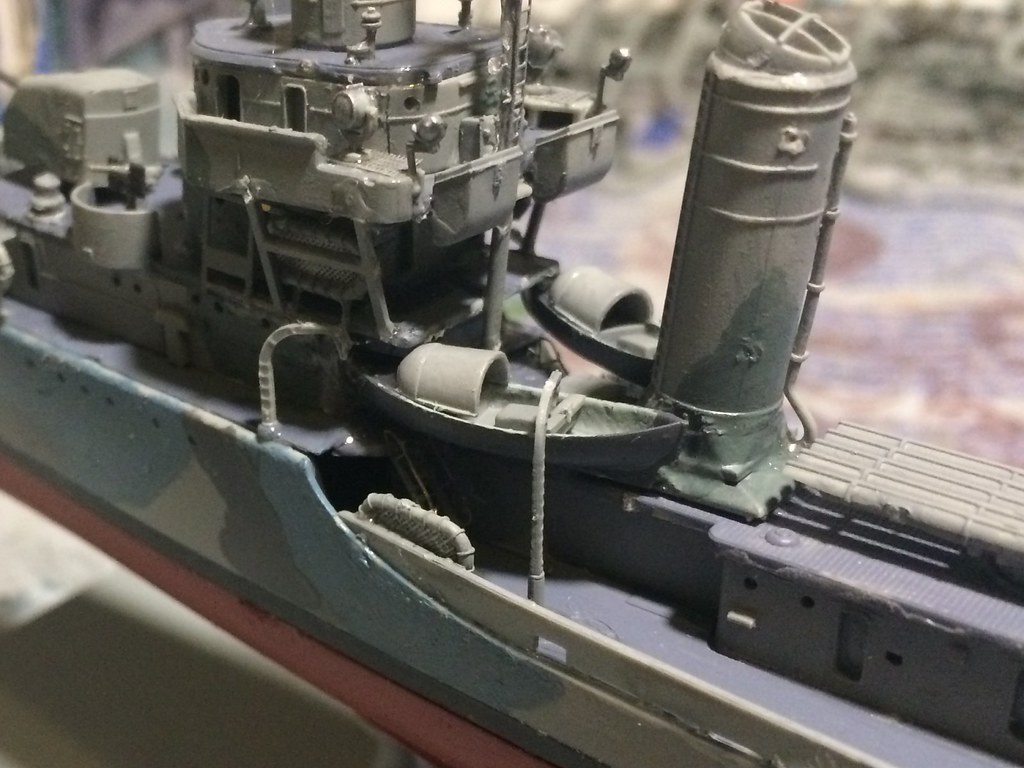

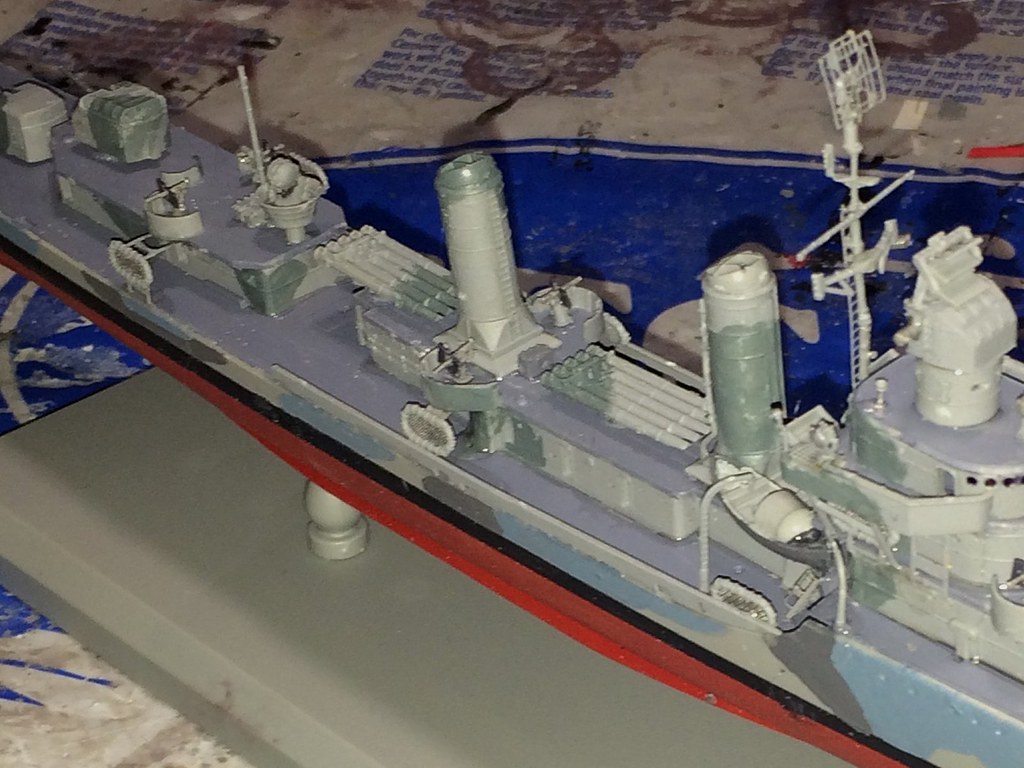
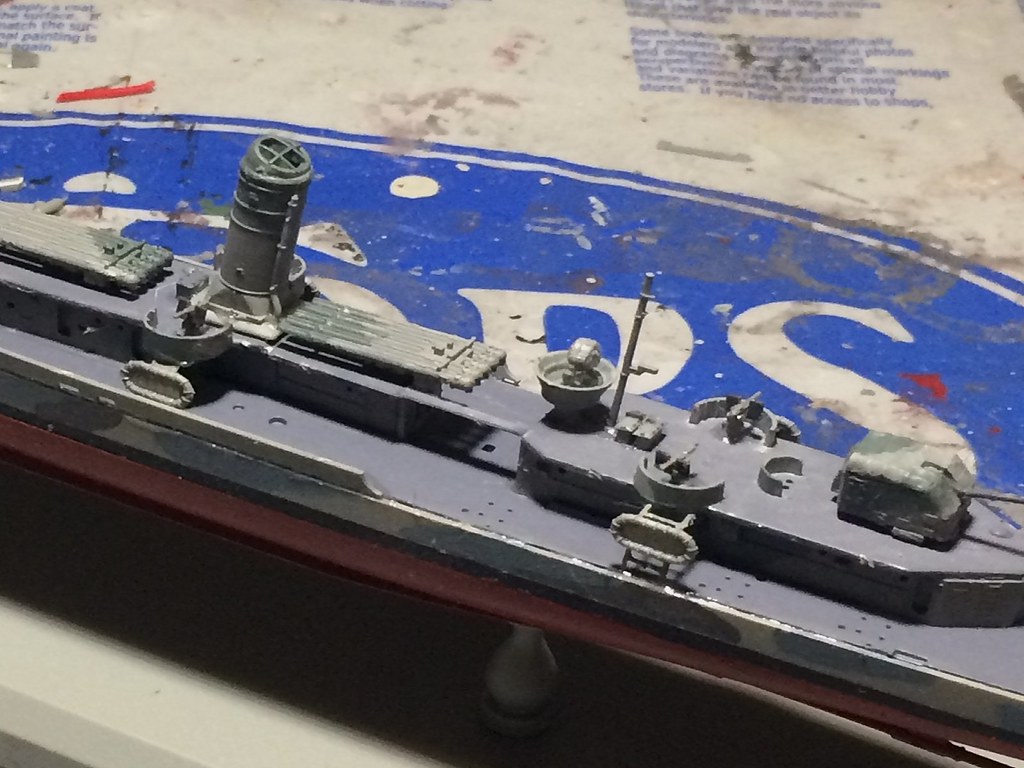
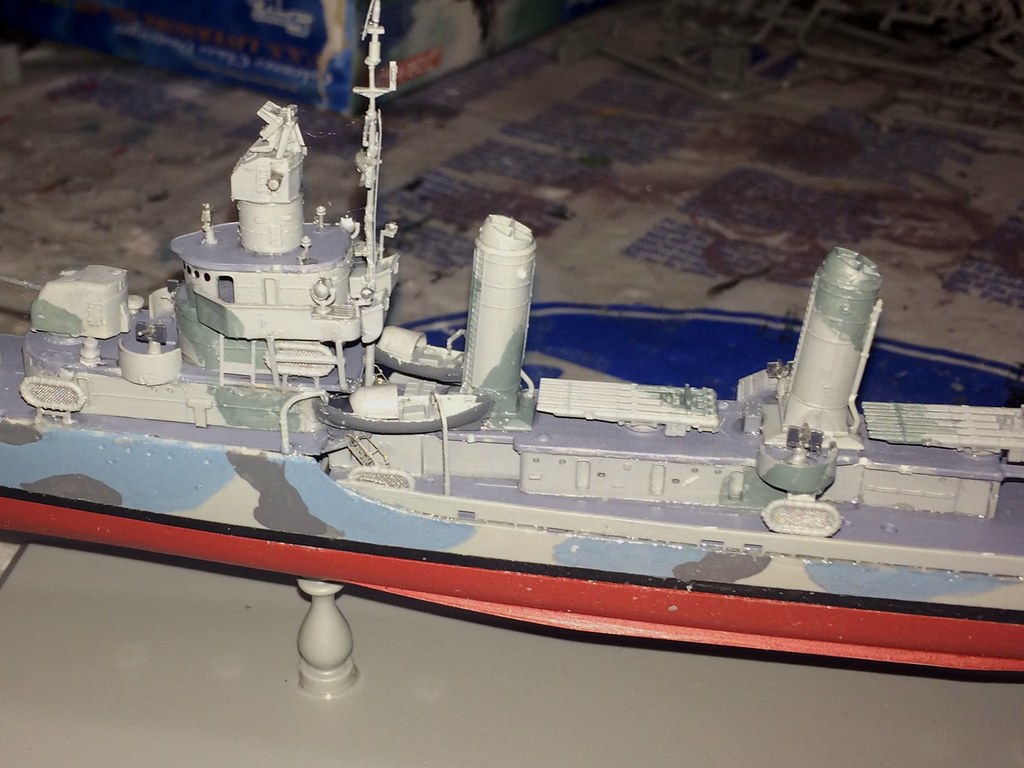
The ship is looking ver nice at this point.
The Build - Depth Charges, deck details, railings - March 5, 2017
At this point I built the depth charge and anti-submarine warfare equipment as well as the MANY deck details and equipment all around the vessel.
When that was completed I then added the railing to the vessel and the decals.
This completed the vessel, but was time consuming because so many of these parts are very small and needed to be carefully attached:

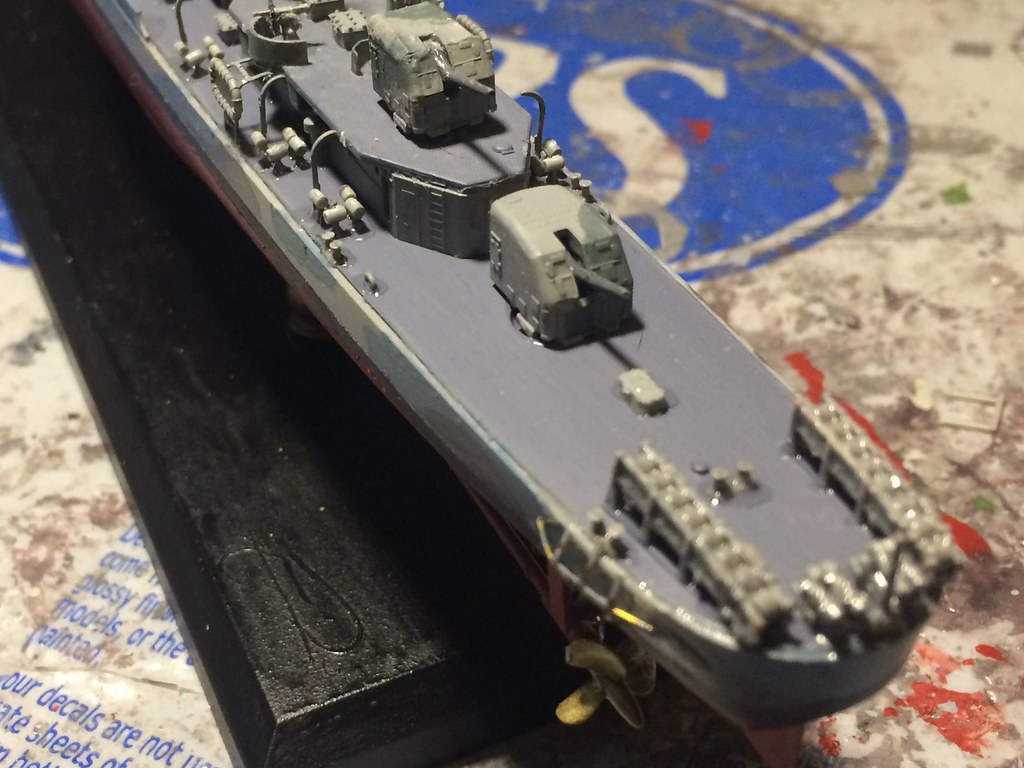

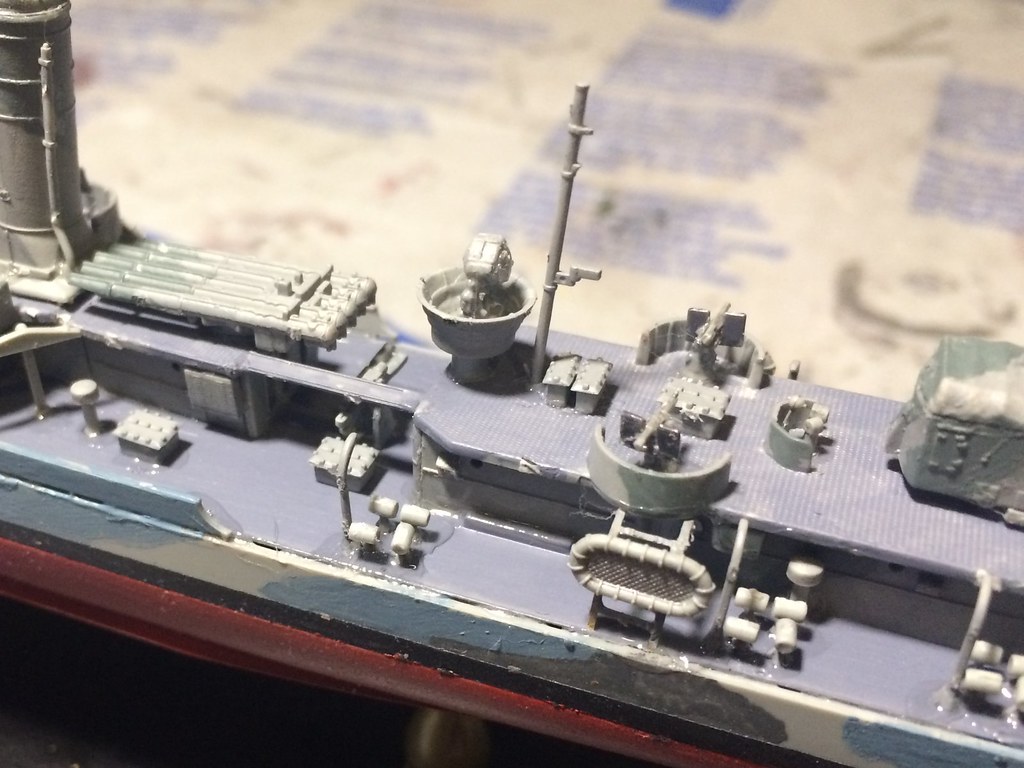
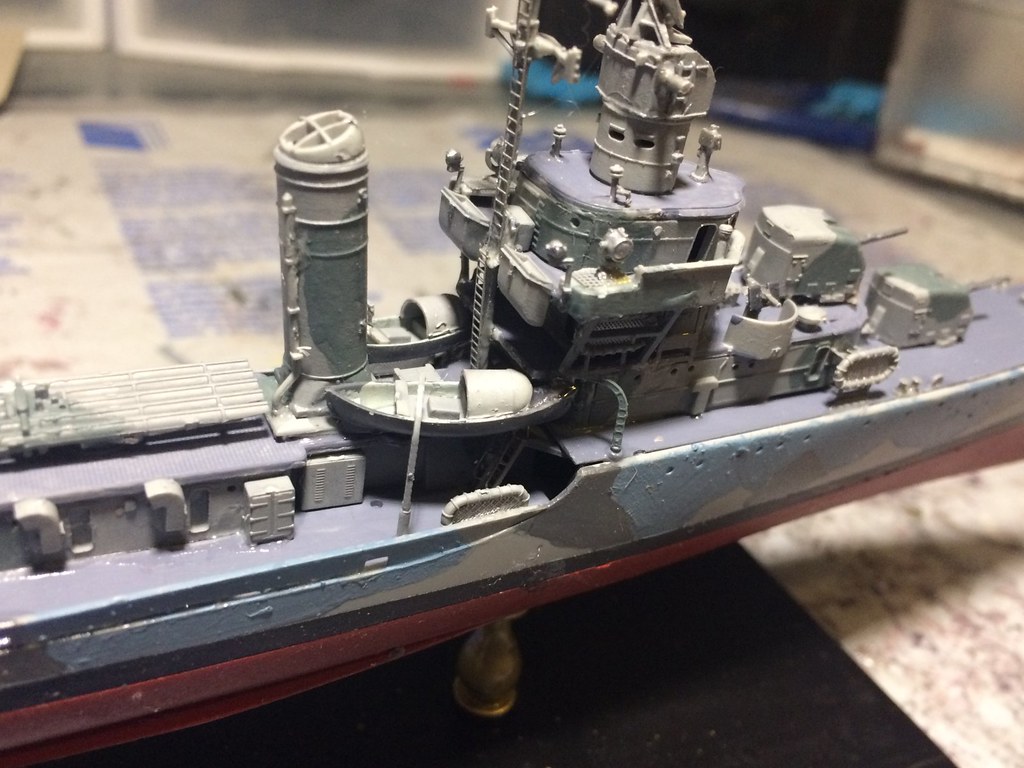
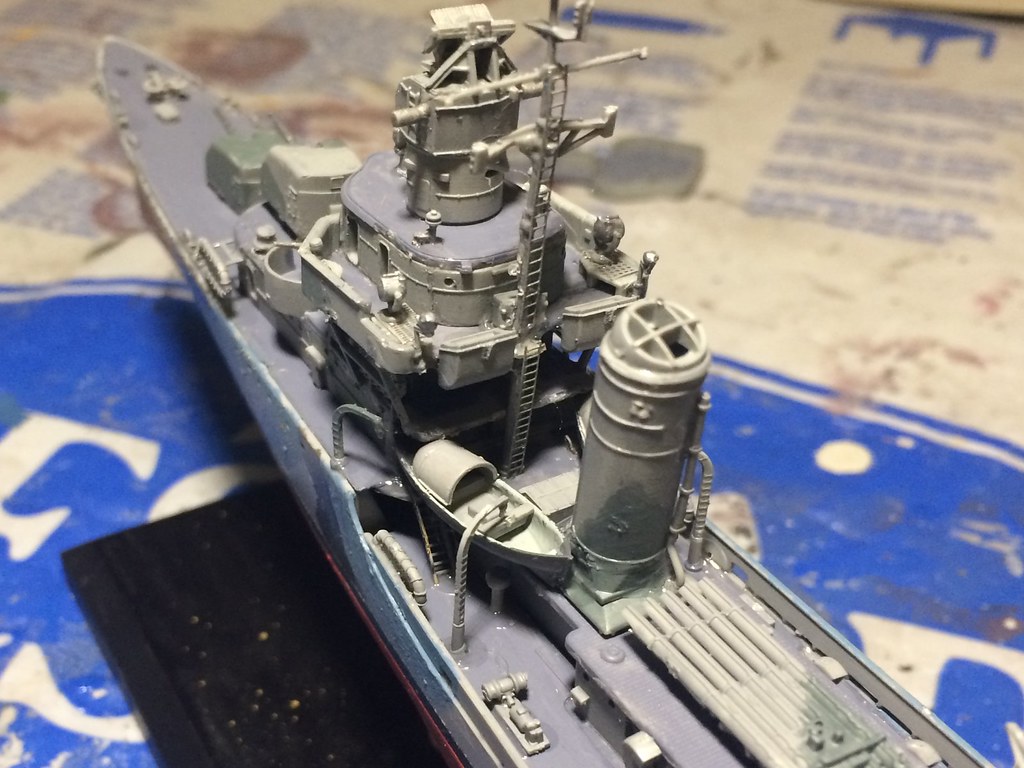

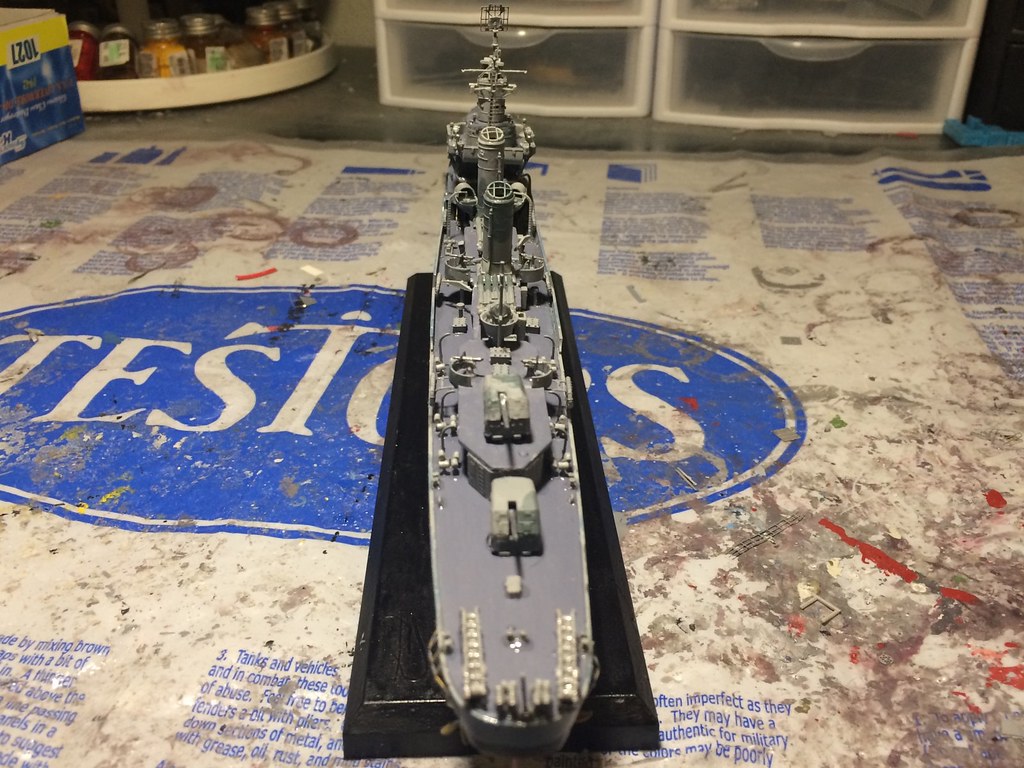

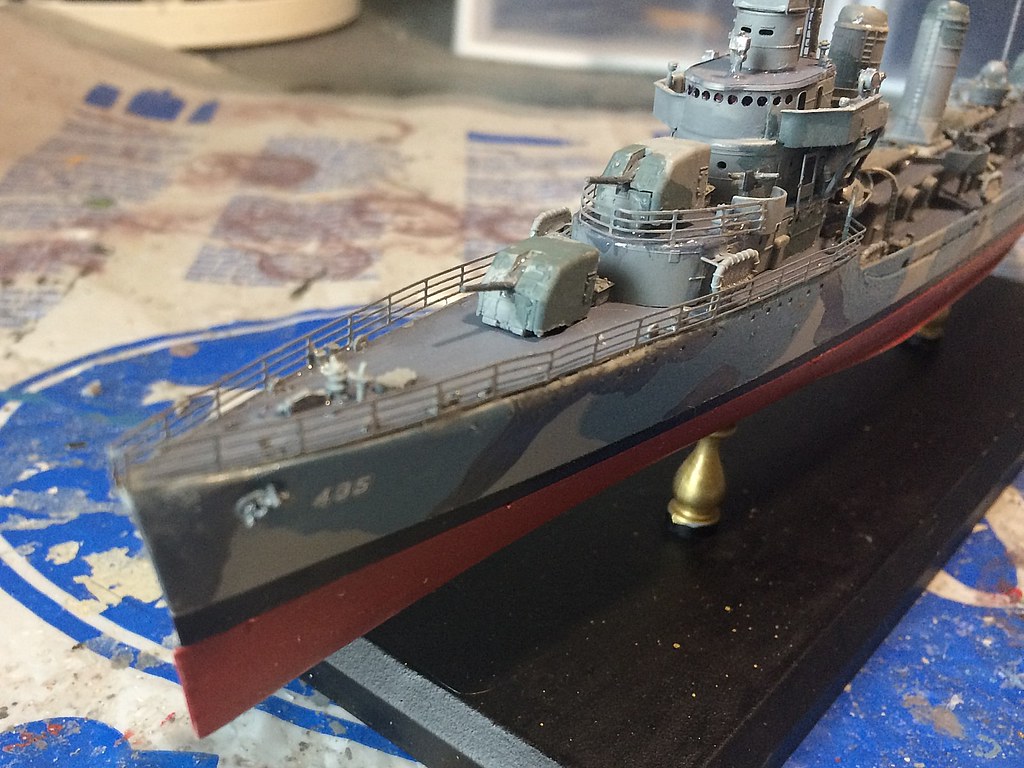
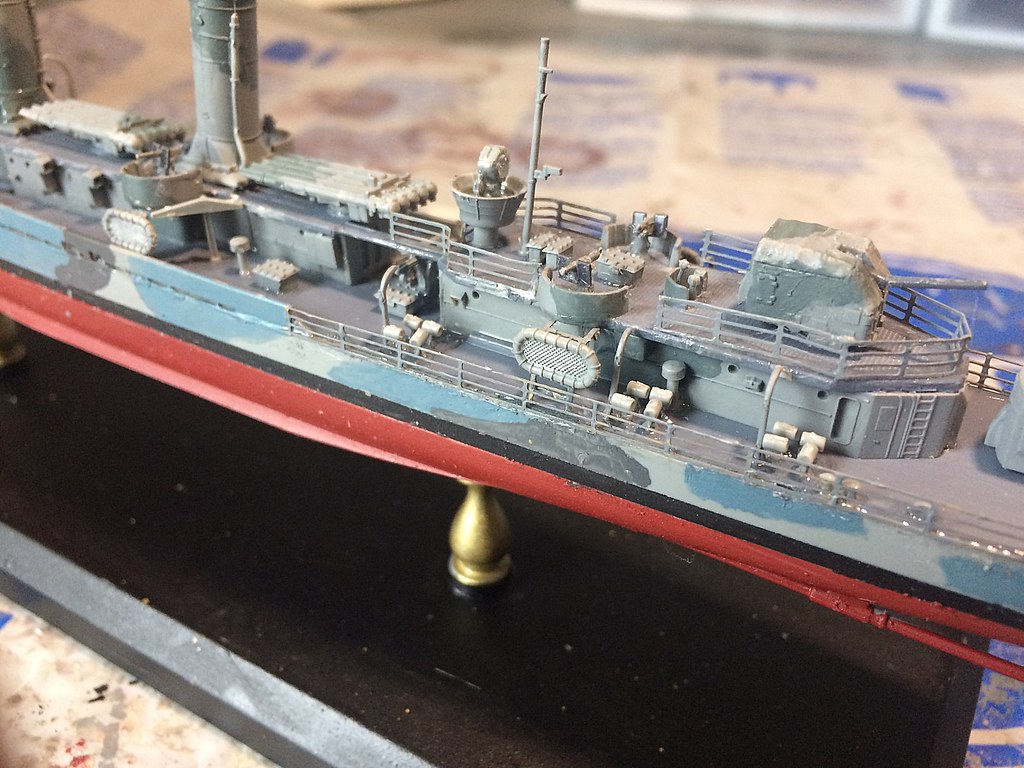
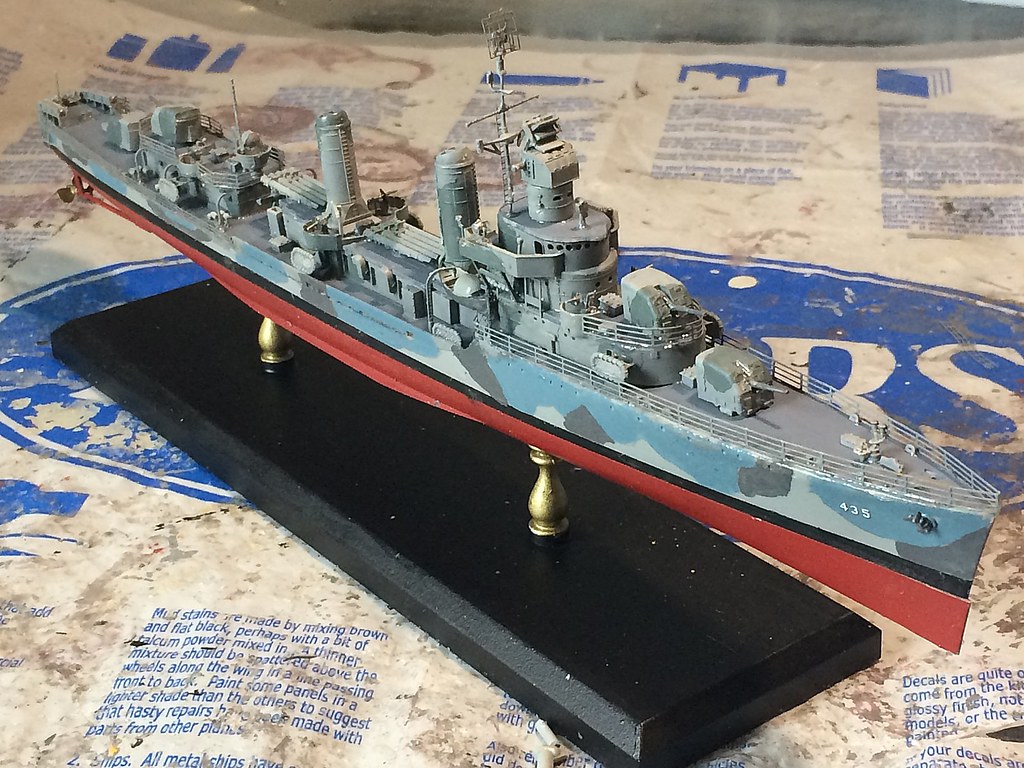
The Build - Final touch up paint, clear dull coat, and completing the model - March 5, 2017
At this point I went around the model and touched up some of the areas that needed final touch up as a result of the building that went on around them after they had been painted and installed.
I then added two coats of dull coat clear paint. This allows the finish that is more glossy from the glue to be rendered dull like the rest of the model so that it all blends in well together.
After theis, the vessel was completed and ready to show off in its final pictures:

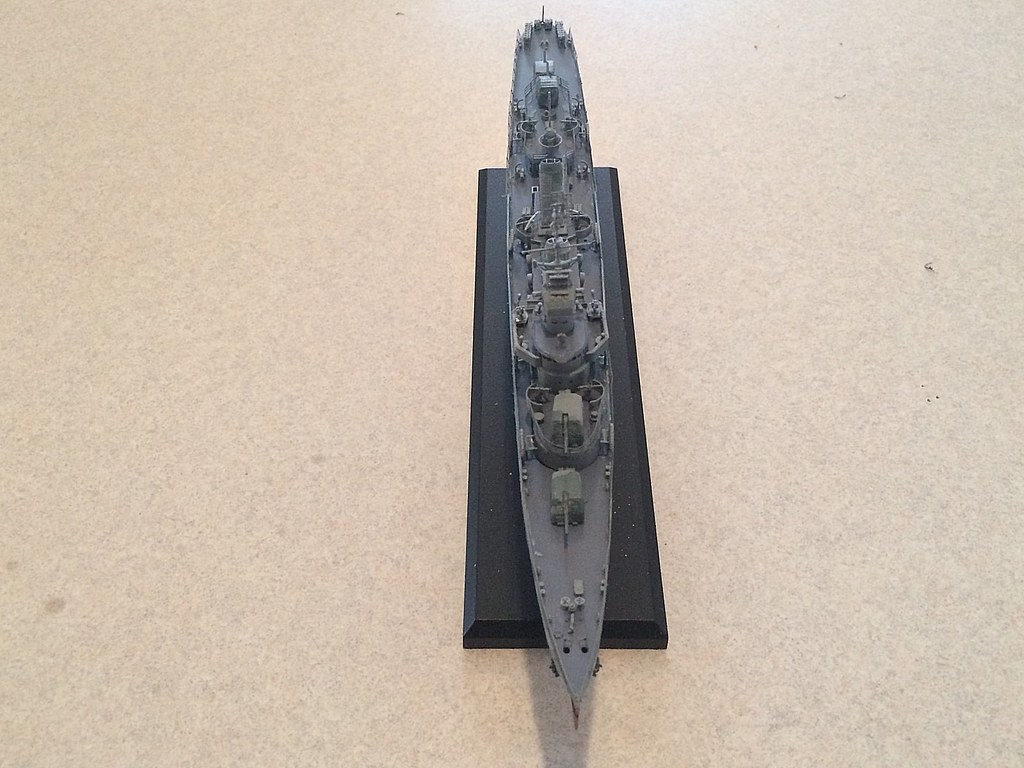

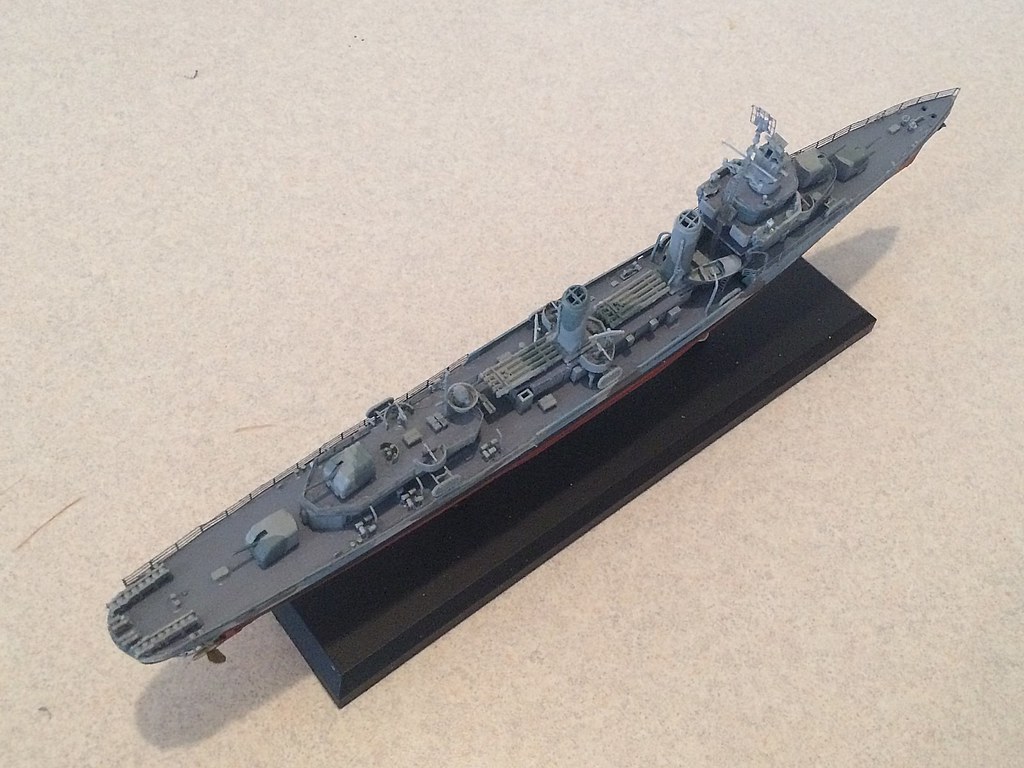
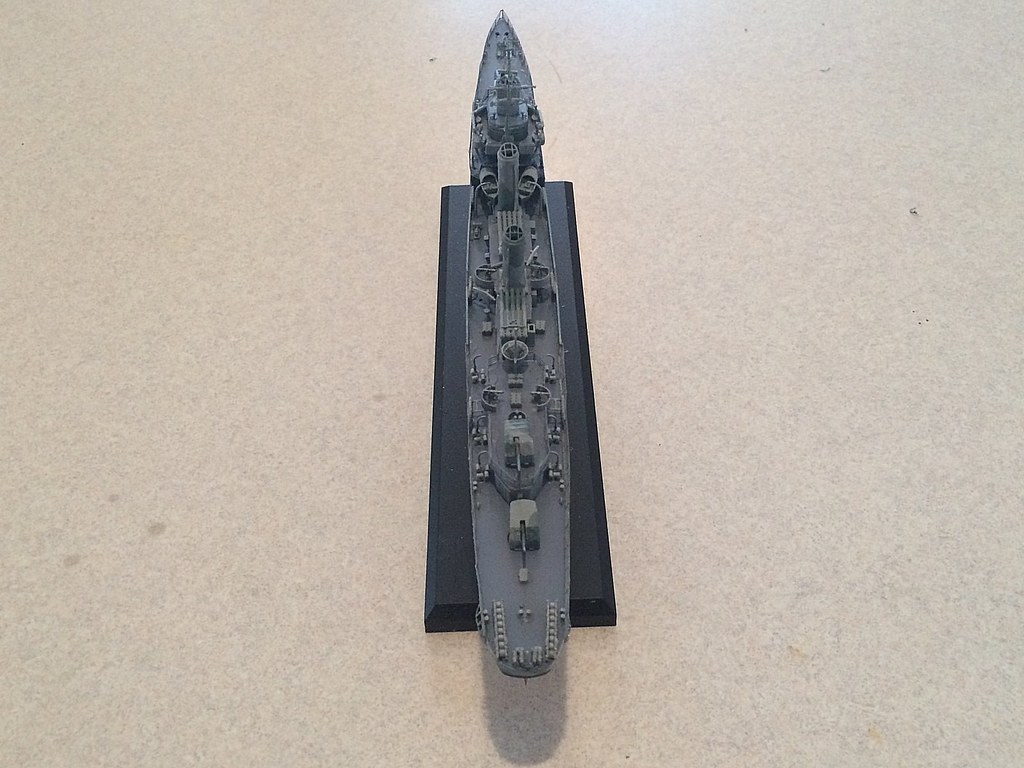
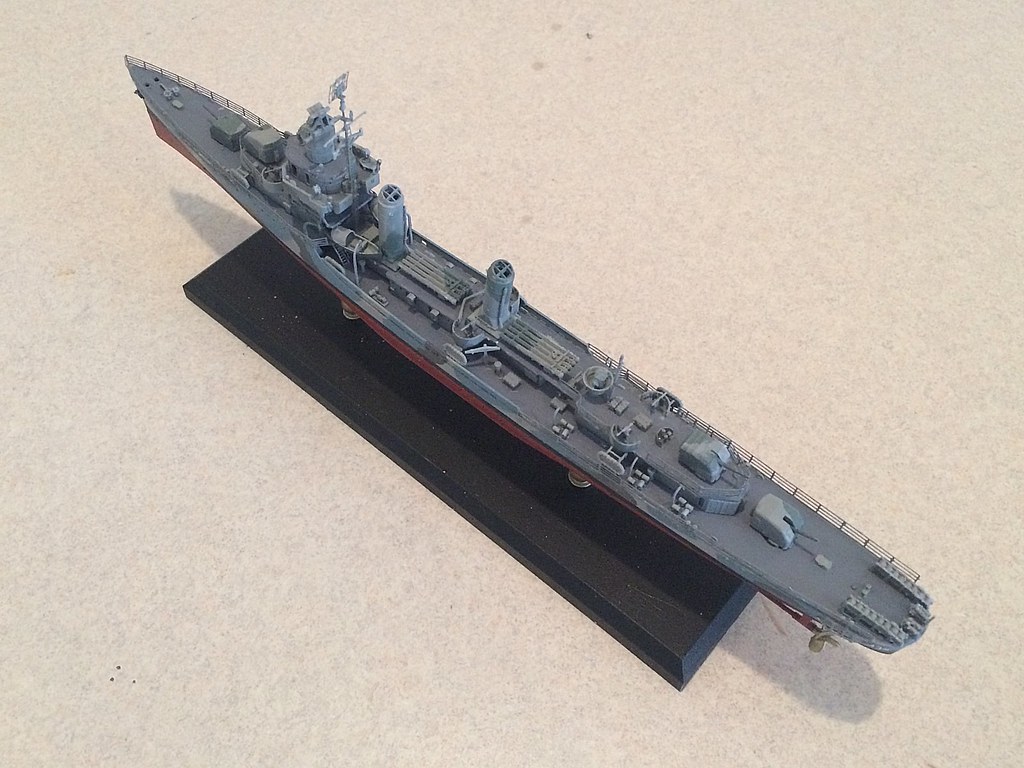
And some close ups:
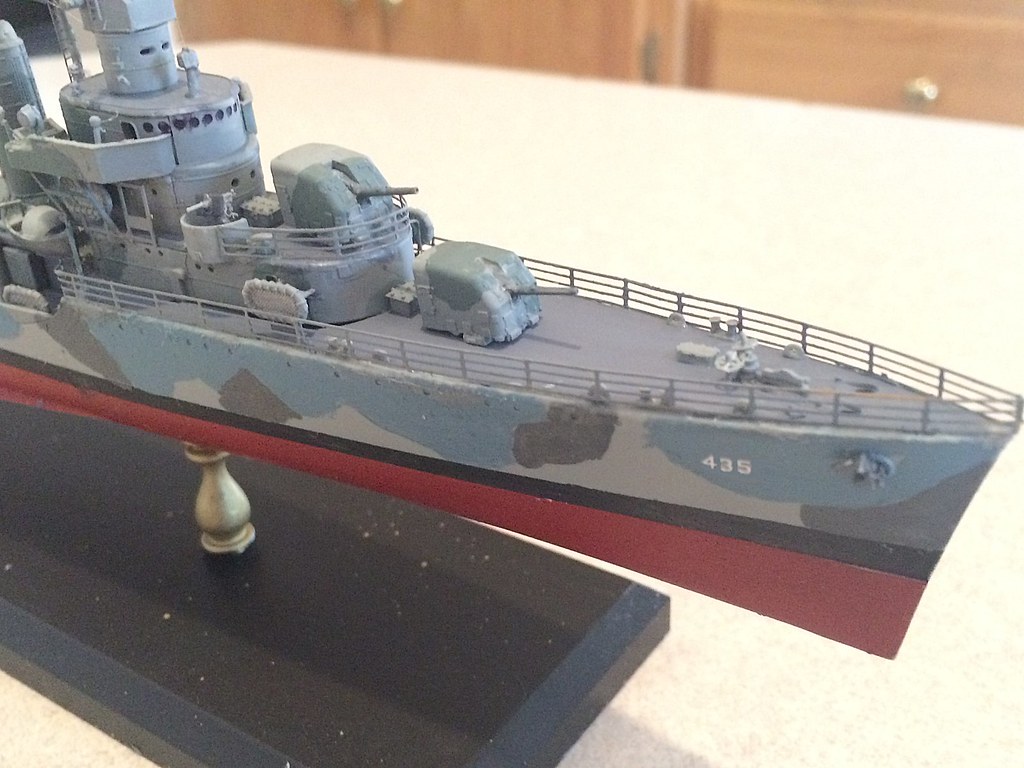


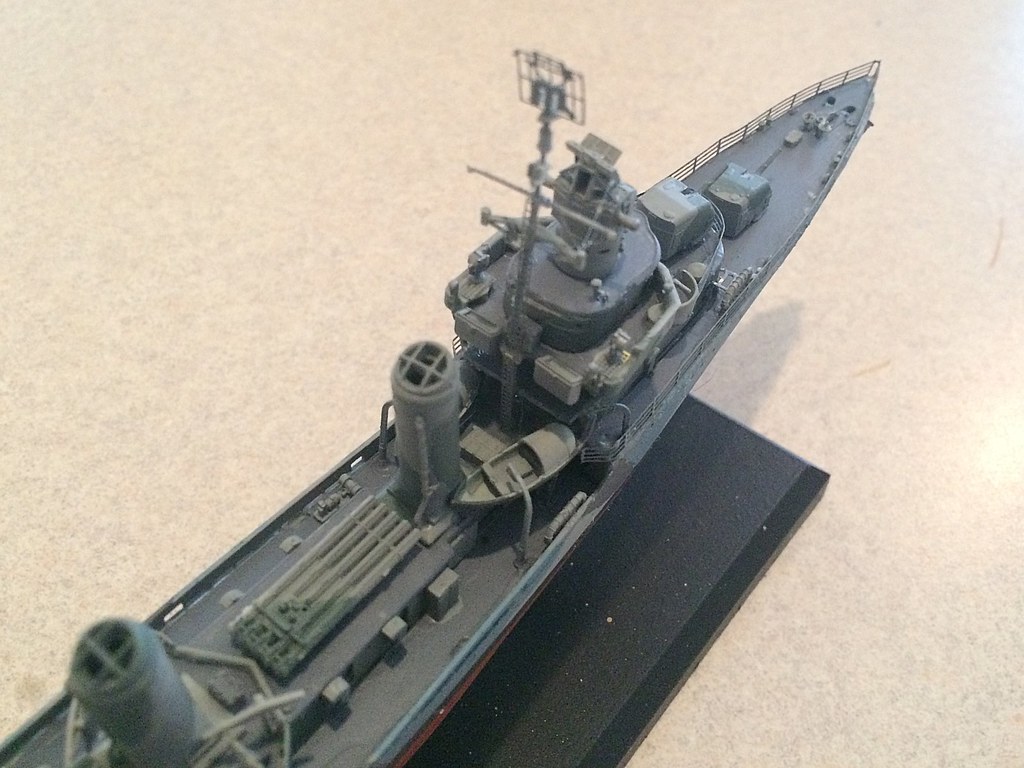
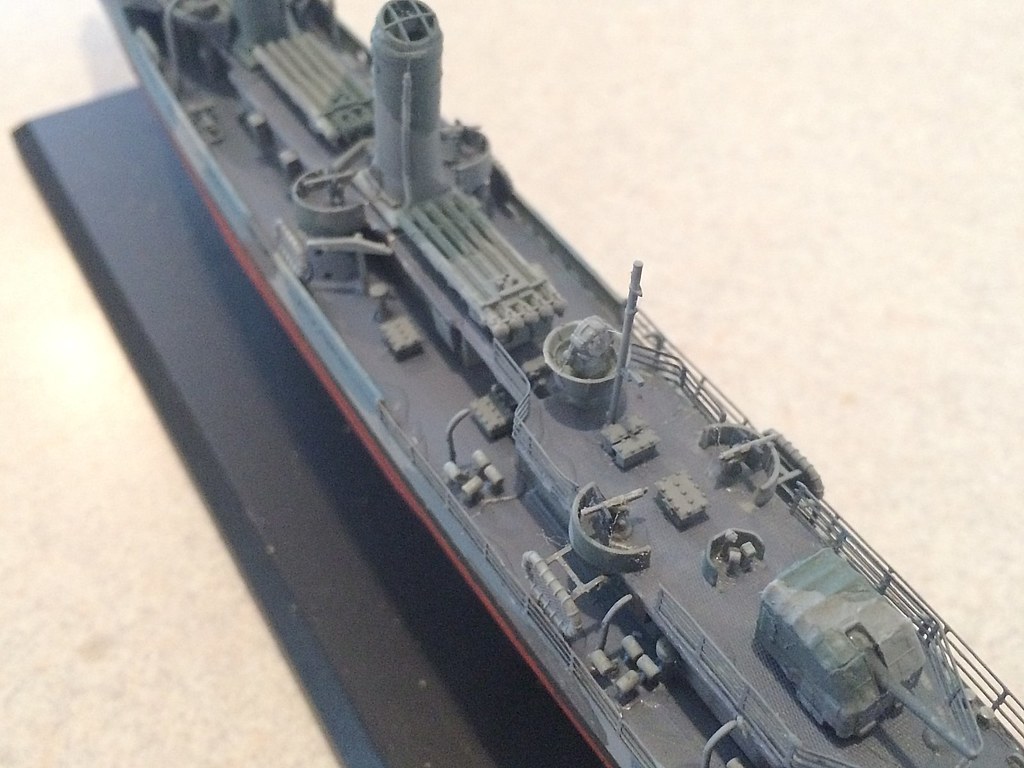

...and finally a couple of shots with the Grayson and the Hornet together:

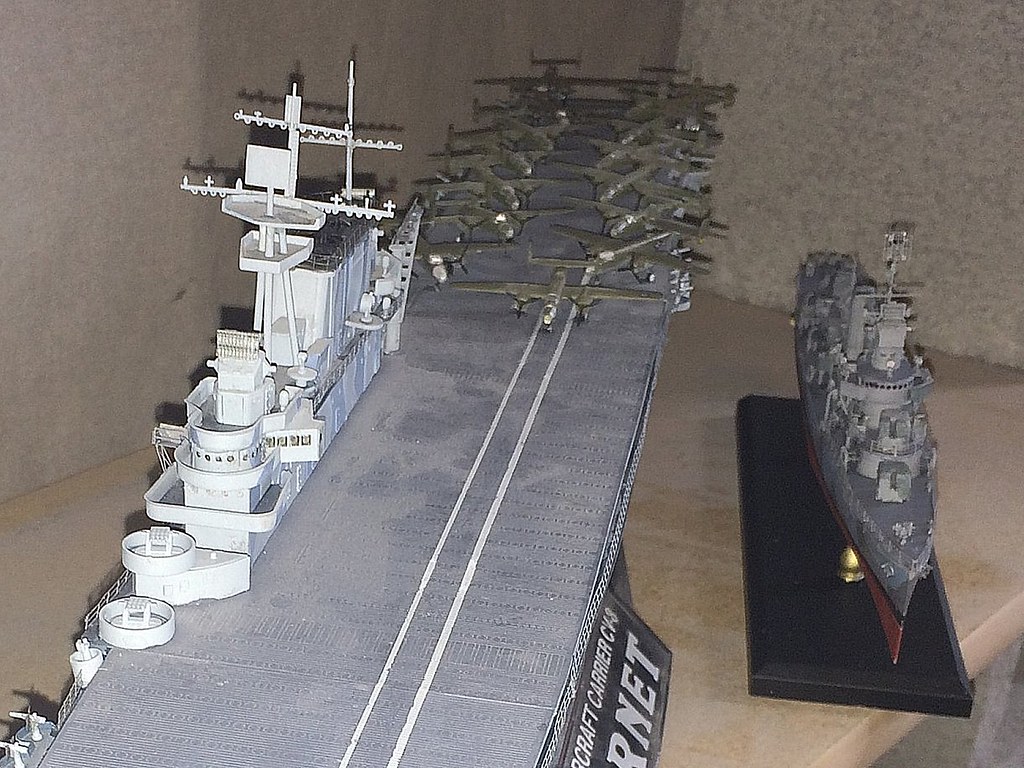
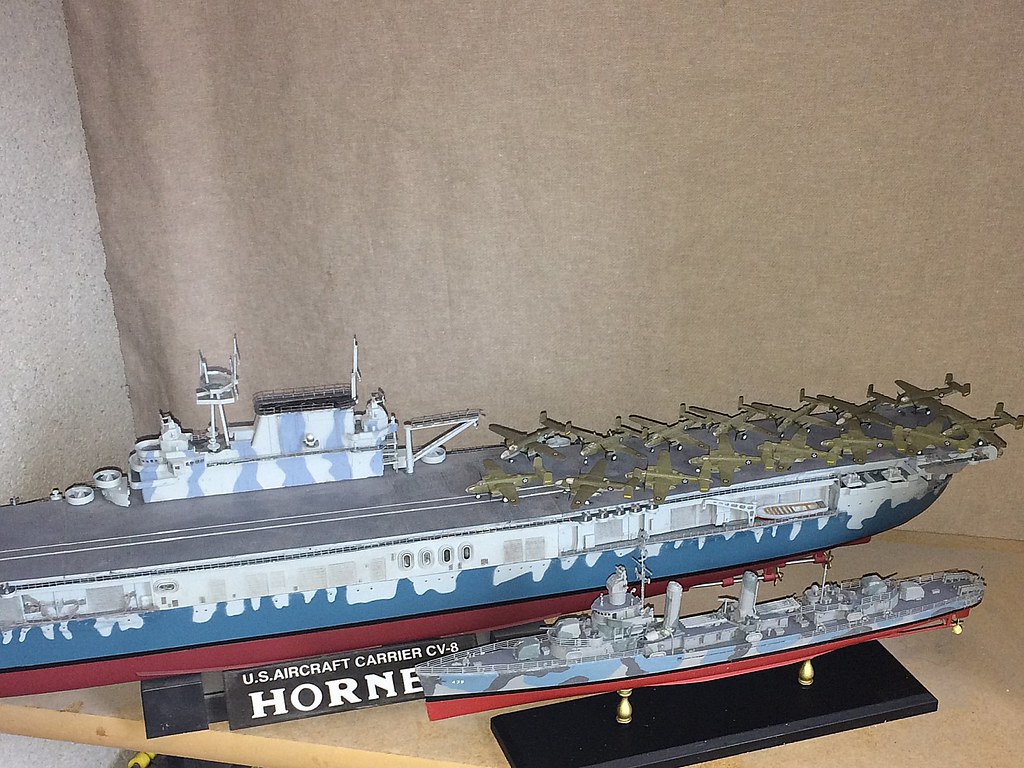
Here - http://cs.finescale.com/fsm/modeling_subjects/f/7/t/174409.aspx
...or on Flickr, here:
Here - https://www.flickr.com/photos/jeff_head/albums/72157679148324531
Awesome!!!
Thnx for the high res pics.
Hope you are doing well...
Outstanding! Thanks for sharing.
Best wishes to you. God bless you.
Thanks !!,
I like the Subject Matter chosen to model, ie; one of
the participant ships in the Dolittle Raids.
This very nice and good job! Excellent job. On a side note I don’t see these model kits on store shelves like I did when I was a kid. I loved putting WW2 planes and model rockets together. The models I so are mostly snap together cars. Sorry about the venting :)
Very Well Done!
Nice
Good to ‘see’ you! How are you doing?
Disclaimer: Opinions posted on Free Republic are those of the individual posters and do not necessarily represent the opinion of Free Republic or its management. All materials posted herein are protected by copyright law and the exemption for fair use of copyrighted works.